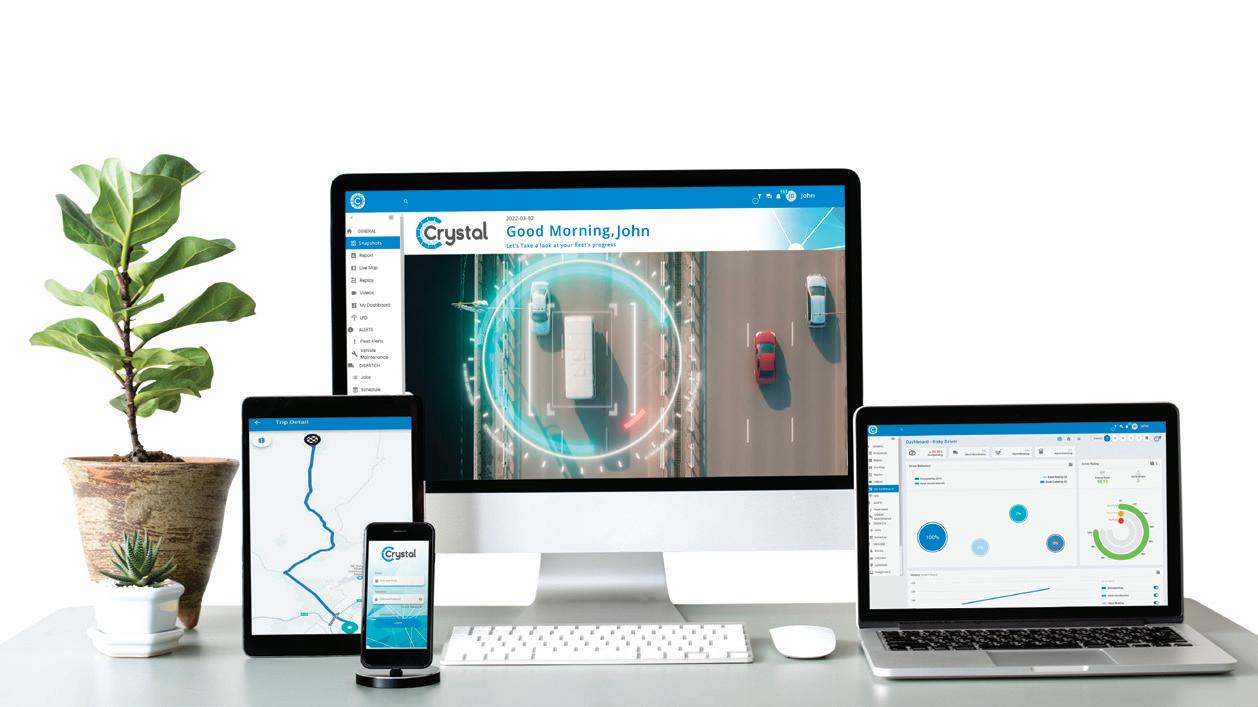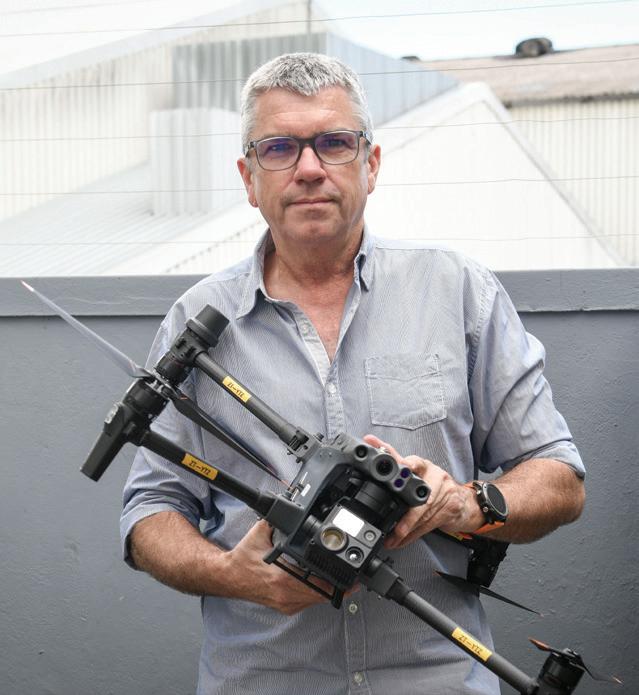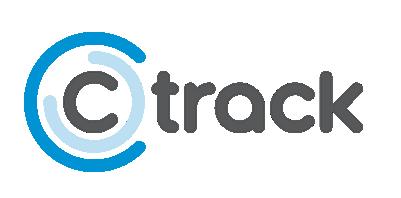



ASSET MANAGEMENT FOR ALL 28 SUCCESSFUL SCAFFOLDING 32 SECURITY AT SKY-LEVEL 35 APRIL 2023 | No 1169

Features Driver Identification & Driving Behaviour Monitoring Engine Performance Monitoring (RPM & Idling) Fuel Level & Consumption Monitoring Iris Camera Solution Front-Back-Side Facing Camera Option Onboard Weighing Breathalyser Tip Sensor Improve your building operation with dynamic Ctrack Solutions. www.ctrack.co.za | sales@ctrack.com | Call Centre: +27 (0)860 333 444 Always Visible
South African Builder is the official journal of Master Builders South Africa, established in 1923. The opinions expressed by contributors are not necessarily those of Master Builders South Africa. SA Builder is a registered trademark of Master Builders South Africa. Any use of this trademark without the express and written approval of Master Builders South Africa is prohibited. No material contained herein may be reproduced in whole or in part without the prior written permission of the publisher. SA Builder © 2023. All rights reserved.

CONTENTS AND CREDITS
PUBLISHER
Isikhova Media (Pty) Ltd

10th Floor, Metal Box, 25 Owl Street, Milpark, Johannesburg, South Africa

Tel: +27 11 883 4627
www.sabuilder.co.za /www.isikhova.co.za
CONTRIBUTIONS
Master Builders South Africa



Tel: +27 11 205 9000
E-mail: editor@sabuilder.co.za
www.masterbuilders.org.za
Free download available on: www.sabuilder.co.za Twitter: @Builders_SA | Facebook: @SouthAfricanBuilder
CAPTAINS
47
Editor: Nicholas McDiarmid
E-mail: nicholas@isikhova.co.za
Director: brand strategy: Jenny Justus
Tel: 083 450 6052
E-mail: jenny@isikhova.co.za
Managing director: Imraan Mahomed
E-mail: imraan@isikhova.co.za
Creative director: Joanne Brook
E-mail: joanne@isikhova.co.za
Operations director: Thuli Majola
E-mail: thuli@isikhova.co.za
Copy editor: Anne Phillips
Advertising sales: Tel: +27 11 883 4627 Mobile: 072 383 3203/083 450 6052
savvy thinkers smart doers together people Proud Media Partner
MESSAGE FROM THE EDITOR 02 Welcoming sub-contractors 02 President’s message COVER STORY 04 AfriSam – Growth in tough markets MBA NEWS 06 The implications of resignation 08 Ergonomic risks in construction 12 Tenders and legal challenges INDUSTRY NEWS 15 Vaal Mall’s infrastructure boost 16 Wind turbine safety challenge 18 Sourcing specialised skills 20 Concrete training gets an entrepreneurial edge 21 Wall protection for health and hygiene 22 Training entrepreneurs 24 Thoughtonomy – a must-read for property pros 26 Volvo leads the electric truck market BUILDING BUSINESS 28 Construction asset management FEATURE
Towering above – new heights in scaffolding
Drones lead move to sky-high security
VIEW
Learnerships – a worthy business hack PROJECTS
Growthpoint’s Trade Park –Phase 2
TECHNOLOGY
Accelerated business through the cloud
VIEW
A new life for Zambezi
River Lodge
32
35
BUILDER'S
36
38
BUILDING
41
GLOBAL
44
Sands
OF CONSTRUCTION
Meet Tracy
APRIL 2023 SOUTH AFRICAN BUILDER 01
Smith
CONTENTS
05 15 32
44
MBA SAFETY COMPETITION NOW OPEN TO SUBCONTRACTORS
Master Builders’ Association regions are getting to work early this year organising their respective safety competitions for 2023, aiming to open the space for more entries.
Each region contributes to the flagship MBSA National Safety Competition, which culminates in the national awards ceremony each year. Very important news this year is the introduction of the subcontractors category. Compliance and safety on site can only be as strong as each link site and sub-contractors’ role is vital to the injury- and damage-free completion of each and every job. The safety and environmental health of a building site are co-creations; they are part of the structure, behaviour, motivation and integral approach to the project itself.
SA Builder encourages all readers to pick up the cudgels by submitting as many entries per region as possible this year, especially in the new subcontractors category. The advantages of engaging in new and refined practices, ongoing improvements through assessment and working at regional and national level with the MBA are demonstrably enriching to every contractor and participant. They also go a long way towards memorialising important projects and the professional profiles of the companies involved.
For all these reasons, please get involved and enter. This edition has its own special focus on health and safety, and – apart from MBA content – our feature on scaffolding is a must-read.
Nicholas McDiarmid, Editor: SA Builder

PRESIDENT’S MESSAGE
While it's too early to stake very much on the reduction of load-shedding in recent weeks, it is a good time to consider what changes we will keep pushing for operationally – and where fundamentals such as energy security should come from. Perhaps a more authentic power structure could be the brainchild of our current national experience.
SPEAKING OF THE MAFIA…
We need to engage urgently and directly with the so-called “construction mafia”. We must tackle the many myths - often rooted in apartheid's violent impact on communities - fueling disinformation about the
construction industry. Profoundly unrealistic expectations of the economic and employment capacities a single construction tender must deliver fuel the violent damage we now expect.
We must tackle the following facts:
• Preferential Procurement Regulations stipulate 30% procurement of goods and services as the empowerment quotient of public sector projects
• Contrary to popular belief, most building contracts yield little monetary gain and tight margins apply all round.
“YES” TO OPEN DOORS
It is especially important in MBA
regions throughout the country that we welcome emerging contractors and smaller subcontractors to our Master Builders community. Right now, public-sector limitations and issues regarding contractor registration add to the flames of frustration. This impairs new entrants’ progress and members’ access to more formalised and reliable sub-contractor services and skills.
The more we can open up our networks, knowledge banks, factual information and support to those aspiring to our industry, the better organised it will be and the more reliable the partnerships that are built.
SOUTH AFRICAN BUILDER APRIL 2023 02 EDITOR'S NOTE










Corner North Rand & Trichardt Road, Bartlett AH, Boksburg BOKSBURG Corner Fourways Boulevard & Roos Street Fourways FOURWAYS Corner Blackrock Street & Stoneridge Drive, Greenstone Park Ext 2, Edenvale GREENSTONE Corner Hendrik Potgieter & Cascades Road, Little Falls, Roodepoort LITTLE FALLS shop online at www.leroymerlin.co.za leroymerlinsa1 leroymerlin.southafrica leroymerlinsa Venezia satin 81480105 Palomino satin 81480106 Verona satin 81480099 Verona satin dark 81480100 Rhodium satin 81480101 Roma satin 81480103 Semi Face Bricks - R1449 per stack of 500 Bonding agent PLASTERGRIP 20l 81470303 R849 Brickforce 2.8mm x 75mm x 20m NHBRC 81415462 Also available in 2.8mm x 150mm x 20m NHBRC 81415456 | R48.90 R48.90 Valid until 30 April 2023. Terms and conditions apply. We’ve got all the building materials you need to complete your contracting jobs without hassle. Cement KBC 32.5N 50kg 81412024 R87 Make your home the best place to live
AFRISAM
SUPPORTS BUILDERS IN A TOUGH MARKET
Facing the relentless competition of the construction sector, small to medium-sized building contractors in South Africa need more than just a product from their cement partner.
Koene Sesele, national sales manager: inland at leading construction material specialist AfriSam, knows these builders and the range of challenges they face.


“The competitiveness of this sector has driven margins down, which makes it more difficult to build up the reserves any business needs if it wants to grow,” says Sesele. “The result is a vicious circle from which it’s hard to escape. The builder lives from hand to mouth – and the transition from one project to the next becomes very tricky.”
NO ROOM FOR ERROR
He notes that builders often get paid late by customers, which
further exacerbates this challenge. These businesses have very little room for error in their projects and ensuring top-quality work and products is how they avoid the risk of call-backs on previous contracts, which can effectively wipe out their margins.
“Among the foundation strategies for a more sustainable business in this difficult market is getting the right support at the outset of every new contract,” he says. “When it comes to cement requirements, this includes getting technical advice from experienced professionals on both the correct product for the job and the optimal preparation.”
He points out that many builders choose their cement on price alone, thinking that all cement is the same. Nothing could be further from the truth. Rather, the difference in the quality of cement available means that a builder could actually use less cement in their mix when choosing a brand like AfriSam.
CONFIDENCE
“By selecting carefully – with due regard to the detailed technical information on the bag – the user can save money by needing less cement per batch,” he explains.
Of course, it is not just the cement that is vital to a quality mix – and this is where the in-house expertise of AfriSam can elevate a builder’s performance to the next level. The company’s experienced personnel – including the experts at its Centre of Product Excellence – can help ensure that the aggregate, sand and water are optimised in the mix.
“Our technical support for builders helps them make informed decisions, thus ensuring that projects are cost-effectively completed to a high standard,” says Sesele. “We even provide formal training opportunities for builders, helping them improve their skills and knowledge in the construction industry.”
VALUABLE INFORMATION
Beyond advice and training, AfriSam has invested considerably
SOUTH AFRICAN BUILDER APRIL 2023 04
(Top): AfriSam offers technical advice from experienced professionals on the optimal use of cement.
(Above): Koene Sesele, AfriSam’s national sales manager: inland.
in developing resources on its products and website for anyone needing that information. Accurate mix designs have been printed on AfriSam cement bags, for instance, to help builders on site achieve the correct usage of the product.
“By pointing out the specifications on the back of our cement bags to inexperienced builders, we’ve been able to demonstrate how using the right grade of cement can save them money,” explains Sesele.

By understanding the different grades of cement, he adds, builders can select a higher grade that will go further – allowing them to buy fewer bags and still produce the same amount of concrete. Other factors they need to consider are early strength, workability and durability, all of which can be optimised with the appropriate selection.
On its website, AfriSam has published a range of “how-to” guides to assist with executing projects, including the correct application of products for a highquality build. The website even includes a calculator which can be used to determine the amount of building materials required for a specific project – such as cement, stone, sand and bricks.
COMMERCIAL ASPECTS
For larger projects, AfriSam’s advice and services can extend to the commercial aspects of the work, explains Sesele. One of the challenges facing a small business is clearly the capital required to initiate the early stages of a project.
“If a project requires a large amount of cement, for example, the upfront costs could drain the builder’s cash reserves,” he says. “In cases like these, we often engage with our customer to carefully forecast how much product they’ll need at specific stages of the project –and then arrange to deliver those smaller volumes only as they require them, over the project’s duration.”
could also raise the credibility of a builder in the eyes of a potential end-customer – giving a level of confidence which is associated with the AfriSam brand.
AfriSam may also offer financing and credit options to builders, making it easier for them to access the materials and services needed for their projects.
“We assess each credit application on its own merits, provided that the necessary securities and guarantees are firmly in place,” says Sesele. When ordering online, builders can also make cash purchases from the company using its secure online payment facility.
He stresses that this conserves valuable capital for the customer, making the project more affordable by taking the time to plan ahead accurately. Apart from the option of bagged cement, AfriSam can also offer contractors bulk supply in silos, which is often more cost-efficient.
EARLY ENGAGEMENT
“To enhance the value of the advice and information that we can give to a builder, they can talk to us as early as the quotation or tendering stage of a contract,” says Sesele. “This means they can get expert input on how to tackle their concrete work in the most efficient and affordable way, while reducing the risks that could threaten the profitability of the job.”
He highlights that a close and visible collaboration with the company
“Overall, AfriSam can help builders overcome challenges by providing access to resources, expertise and support,” he says. “When this input from us is put to good use, it can help builders grow their businesses and compete in a challenging market.”
• Visit: www.afrisam.com

APRIL 2023 SOUTH AFRICAN BUILDER 05 COVER STORY
(Above): AfriSam offers technical advice from experienced professionals on the optimal use of cement.
(Above): Builders need to ensure that the quality of their work and products is always top-class.
DISCIPLINARY ACTION AFTER RESIGNATION

WITH IMMEDIATE EFFECT
By Jan Truter, www.labourwise.co.za
There has been uncertainty about an employer’s right to proceed with disciplinary action after an employee’s resignation “with immediate effect”. A judgment of the Labour Court in Cape Town has provided much-needed clarity.
In a previous case before the Labour Court, Mtati v KPMG Services (Pty) Ltd (2017), the judge granted an interdict against the employer, who wanted to proceed
with disciplinary action against an employee who had resigned with immediate effect. The judge reasoned that “… the termination of the employment contract with immediate effect took away the right of the first respondent [the company] to proceed with the disciplinary hearing against her”. The court declared the disciplinary hearing null and void and set it aside. (We held a different view and discussed the judgment in an article in January 2018.)
Although the judgment was overturned on appeal, the Labour Appeal Court (LAC) – in setting aside the Labour Court’s order – replaced the judgment with an order that read: “The application is dismissed on the grounds of mootness.” Unfortunately, the LAC provided no further clarity on the matter.
A DIFFERENT OUTCOME
A similar situation led to a different outcome in the Labour
SOUTH AFRICAN BUILDER APRIL 2023 06 MBA NEWS
(Above): Labour law remains unclear on the issue of resignation and determining the binding effects of what employers accept.
Court case of Coetzee v The Zeitz MOCAA Foundation Trust (2018). Coetzee was the executive director and head curator of the Zeitz Museum of Contemporary Art Africa. On 15 May 2018, the employer handed him a letter inviting him to make written representations in respect of allegations of serious misconduct. He was put on “precautionary suspension” and requested to respond by no later than 12 noon on 29 May 2018, failing which the employer would proceed with appropriate disciplinary action.
The next day, 16 May 2018, Coetzee approached the employer, saying that he wanted to tender his resignation. This resulted in an agreed statement in which the employer announced to the press that “an enquiry into Mr Coetzee’s professional conduct has been initiated by the trustees. Mr Coetzee has since tendered his resignation.”
When the employer insisted on proceeding with the disciplinary
process, Coetzee approached the Labour Court to obtain an urgent interdict against the employer, preventing him from continuing and finalising the disciplinary process. He also requested the court to declare any disciplinary steps that might have been taken after his “immediate” resignation null and void.
According to the employer, it had never agreed to Coetzee resigning with immediate effect, nor did it
waive its right to notice. It insisted that Coetzee was required to give at least the statutory minimum of four weeks’ notice. On the facts before it, the court favoured the employer’s version that it had not agreed to an immediate resignation. This meant that the notice period would expire on 22 June 2018.

THE LAW
The court referred to contract law and confirmed that “an employee’s contract of employment comes to an end only once his/her resignation takes effect at the end of his/her notice period”. By resigning with immediate effect, an employee is therefore in breach of contract. The employer has a choice: firstly, it may hold the employee to the contractual notice period. (In legal terms, this is known as “specific performance”.) Secondly, the employer may “accept” the resignation, cancel the contract and claim damages. (In legal terms, this is known as “accepting the employee’s repudiation” of the contract.) In Coetzee’s case the employer elected to hold him to the contract. It therefore had the right to take disciplinary action. The court dismissed Coetzee’s application.

CONCLUSION
The implication of this case is that an employer may proceed with disciplinary action and dismiss an employee before the contractual notice period expires. Employees therefore cannot escape the consequences of their actions by resigning with immediate effect. Hopefully, this is the final word on the law in this regard.
APRIL 2023 SOUTH AFRICAN BUILDER 07 MBA NEWS
(Above): The implications for disciplinary action if an employee resigns depend on the legality of the immediacy of the resignation.
“BY RESIGNING WITH IMMEDIATE EFFECT, AN EMPLOYEE IS THEREFORE IN BREACH OF CONTRACT.”
BARRIERS TO THE MANAGEMENT OF ERGONOMIC RISKS IN CONSTRUCTION



 By Sma Ngcamu-Tukulula (CPE), Smart Ergonomics
By Sma Ngcamu-Tukulula (CPE), Smart Ergonomics
The construction industry is complex and the dynamic nature of construction work systems makes them highly susceptible to internal and external changes. Construction work environments are not only challenging to manage, but are also notorious for being responsible for some of the highest accident and injury rates compared with other industries. Given the manual labour-intensive, safety-critical nature of construction tasks and the pressure to run profitable operations, there is always a need for innovative solutions that can assist the construction industry to meet its health and safety obligations, while also optimising production outputs.
Internationally and locally, organisations facing similar challenges to those in the construction industry have turned to ergonomic principles, approaches, methods and tools to help them design more resilient work systems where productivity is achieved without compromising workers’ health and well-being. Numerous case studies have documented the benefits associated with managing ergonomic risks, which include a reduction in the number of accidents and injuries experienced, fewer errors and higher levels of quality and productivity.
WHY ERGONOMICS IS IGNORED
With these examples of gains made through managing ergonomic risks, one would expect a widespread implementation of er-
gonomics across the construction industry. However, the management of ergonomic risks remains low. What could be the reason for this? Based on experience and discussions with various organisations, I have identified commonly occurring factors that seem to hinder the implementation of ergonomics. While these are not an exhaustive list of barriers to implementing ergonomics, they offer some insights that may assist construction organisations who are grappling with the question of why they should implement ergonomics or what potential hurdles they may have to overcome in order to do so.

SOUTH AFRICAN BUILDER APRIL 2023 08 MBA NEWS
(Above): Awareness, correction, exercises: time extremely well spent in minimising injury and downtime on site.
(Right): Ergonomic work design is crucial, yet often ignored, on construction sites.
COMPLIANCE IS A START, EMBEDDING IS THE GOAL
While it may be widely accepted that legal and regulatory requirements for the management of health and safety risks must be observed, it is not uncommon to find organisations which fail to do so. This is also true when it comes to the management of ergonomic risks in industries across South Africa, including the construction industry.

The promulgation of the Construction Regulations of 2014 and the Ergonomics Regulations of 2019 provided explicit requirements for the management of ergonomic risks in the construction industry. This was not a new requirement, since ergonomic risk management was already implicitly indicated in the Occupational Health and Safety Act, 85 of 1993. However, the introduction of the Construction Regulations and the Ergonomics Regulations shone a much-needed spotlight on ergonomics and brought it into the radar of construction organisations, many of which were not implementing it. The need to comply with these legislative imperatives thus became the trigger that led such construction organisations to take action to manage ergonomic risks.
However, without continuous enforcement, there is a risk that compliance-driven construction organisations will not sustain the management of ergonomic risks. Moreover, in the absence of an understanding of systemic ergonomic-related risks, such
construction organisations are also unlikely to be able to embed ergonomics into their safety management systems. In other cases, it has been observed that some compliance-driven organisations tend to implement ergonomics only at a superficial level in order to tick the proverbial compliance box. It can thus be argued that the presence of legal requirements alone has not assisted the construction industry to manage ergonomicrelated deficiencies. In an industry with low levels of compliance to minimum requirements for managing ergonomic risks, legislation is a critical catalyst for change. However, more ergonomic education and awareness is required to help the construction industry understand

and effectively embed ergonomics within their operations.
To bridge this gap, Master Builders KwaZulu-Natal (MBA-KZN) now offers training and awareness in various ergonomic topics aimed at construction personnel from entrylevel to executive management. Contact the branch to discuss your ergonomic training needs and keep an eye on its social media platforms for information on upcoming ergonomic training.
COST BENEFITS OF IMPLEMENTING ERGONOMICS
When organisations implement new requirements, resources need to be allocated to introduce and maintain that change in a sustainable manner. Organisations that had not previously been managing ergonomic-related risks have expressed concerns regarding the financial implications of embedding ergonomics within their organisations. While the cost of introducing ergonomics will vary between different organisations, resources are required to conduct risk assessments, update medical surveillance programmes, provide
APRIL 2023 SOUTH AFRICAN BUILDER 09 MBA NEWS
(Below): Investing in signage can yield
ergonomic education and training for workers and management, and update policies and procedures, as well as many other associated activities. However, focusing on the cost of implementing ergonomics is only one side of the coin.
Often, negative system outcomes such as worker injuries and illnesses, reduced quality of output, absenteeism, high worker compensation costs, high insurance premiums, incidents and accidents are linked to ergonomic deficiencies across the organisation’s system. Many organisations that do not have existing measures to effectively manage ergonomic-related risks are usually oblivious to the fact that unmanaged ergonomic-related deficiencies are a major contributor to negative organisational outputs. They are also usually unaware of the cost of not implementing ergonomics, because this is often not measured or considered appropriately.
EXAMPLES
More and more accident investigation reports in safetycritical environments are identifying various systemic ergonomic-related deficiencies to have contributed to those incidents. Evidence also suggests that ergonomic interventions and programmes contribute to the prevention or reduction of accidents. One example is the costly impact of musculo-skeletal disorder on workers in an organisation where they are exposed to unmanaged physical, cognitive, organisational
and psychosocial risk factors. These disorders include lower back pain, carpal tunnel syndrome and shoulder pain, the costs of which are borne by the workers in terms of deteriorated health and performance. The organisations are also not spared, as they must shoulder the costs associated with absenteeism of affected workers, lowered performance outputs and higher compensation costs.
The benefits of introducing ergonomics can outweigh the costs associated with not doing so. Finding more cost-effective ways of managing ergonomic risks, particularly in the construction sector, is vital.
Additionally, construction organisations should be equipped and supported to unearth and effectively manage the ergonomicrelated deficiencies in their systems. They should also be capacitated to measure the cost of ergonomicrelated deficiencies in workers and organisational performance so that these help inform risk managementrelated decisions.
ENABLING CHANGE
As critical decision-makers in construction organisations, managers can also be influential stakeholders who can assist in getting the rest of the organisation on board when it comes to introducing ergonomics.
Managers need to be supported and enabled to make decisions and
drive the necessary ergonomic changes. One way is by providing the relevant information regarding the status of ergonomic risks within an organisation and explaining the consequences associated with unmanaged ergonomic risks.
MBA-KZN provides ergonomic awareness through various means, including webinars and awareness campaigns. Through its ergonomic advisory and consulting services offered by competent professionals, the branch provides various ergonomic assessments that can provide the empirical evidence needed to empower construction managers and workers. This includes gap analyses, ergonomic risk assessments, assessments to quantify exposure to ergonomic factors across the organisation’s system and the development of tailored solutions to effectively manage identified ergonomic-related deficiencies. Ergonomic assessments can help managers make informed decisions about the ergonomic risks in their organisations and the cost benefits of implementing changes.
OVERCOMING THE BARRIERS
The barriers to implementing ergonomics vary from one construction organisation to another. Through providing a suite of ergonomic services, MBA-KZN – through its partnership with Smart Ergonomics – is contributing to existing efforts to make the construction industry safer and more competitive.
SOUTH AFRICAN BUILDER APRIL 2023 10 MBA NEWS
“SOME COMPLIANCE-DRIVEN ORGANISATIONS TEND TO IMPLEMENT ERGONOMICS ONLY AT A SUPERFICIAL LEVEL IN ORDER TO TICK THE PROVERBIAL COMPLIANCE BOX.”
BUILT E NVIRONMENT
T R A INING CONF ERENCE
Leadership, Mentorship, Technologies and Skills Development
Date: 17, 18 & 19 May 2023
Yonwaba Mfingwana

Deputy Director: Infrastructure Finance GOVERNMENT TECHNICAL ADVISORY CENTRE- ENTITY OF THE- NATIONAL TREASURY
Nompumelelo Nzuza

Managing Director/SACAP Board
Member
NZUZA ARCHITECTS CO-OPERATIVE
Mazande Ntshanga
Local Economic Development
Project Manager Capital Projects UnitEconomic Development & Planning Cluster
ETHEKWINI MUNICIPALITY
Sanelisiwe Ntshanga Town Planner
Mameetse Masemola
DDG: Infrastructure Investment Planning and Oversight
INFRASTRUCTURE SOUTH AFRICA
Buhlebethu Sithole
National Manager: Development Planning & Infrastructure Delivery (RSA) AMANDLA SOCIAL ENTERPRISES



Dr Emma Molobi
Principal Engineer (Rolling Stock Technology)

TRANSNET FREIGHT RAIL
Nonelela Xaba (Noni) Divisional Human Resources Director SPAR SOUTH RAND
Dr Thelma Ngwenya Engineer MINTEK
INTERACTIVE WORKSHOPS
INVESTING IN MENTAL HEALTH CARE FOR WOMEN IN THE BUILT ENVIRONMENT
Senzekile Shongwe
Counsellor & Mental Health Facilitator
ITC is excited to announce the roll out of an out of this world experience As part of the conference delegates will participate in a half-day tour through Soweto, join us for this exciting initiative on day 2. The tour includes a visit to the following places: Mandela House, Hector Peterson Museum, Freedom Square, Drive through Orlando Towers as well as Vilakazi Street & a buffet lunch at Sakhumzi.

Venue: Gallagher Estate, Midrand

Mathabo Masegela
Senior Manager Planning: Engineering ROADS AGENCY LIMPOPO
Verosha Ganas
Specific Design Project Management (SDPM) Technology, Development & Innovation
TELKOM
Nonku Hlatshwayo
Interior Designer- Managing Director-CEO JUZETTA INTERIORS
Xoli Khoza
Lead Project Manager- KZN Region MAFANYWA MPHAGE QS AND PM
Sitha Mgezuma
Section Head: Asset Operations (Property Management)

SOUTH AFRICAN POLICE SERVICE
MONITORING AND EVALUATION (M & E) IN THE BUILT ENVIRONMENT

Dr Peter Tobin Chief Executive Officer PETER TOBIN CONSULTANCY (PTC)
Optional Critical Skills Workshop
Experts will teach delegates on the different kinds of reptiles that can encountered on site or remote areas while working. You will learn how to identify the different reptiles, risk associated with them, safety handling as well as alerting the right authorities to ensure safety. This is a critical skill for Women in Built.



NETWORKING FUNCTION FOR ONSITE ATTENDEES & LIVE PERFORMANCE BY VICTOR PHILLIPS

KEY STRATEGIES TO BE DISCUSSED
• Discussing the current statistics and inclusion of women in the built environment, what has been done? Are we reaching the desired goals?
• Transformation through Professional Registration in the Built Environment
• Promoting the involvement of Women in Construction Welding


• Sustaining injury free workplaces through effective Health & Safety measures
• Technical Report Writing
• Exercising emotional intelligence by acting and leading in a more effective manner
• Ensuring women take a seat at the table and make a change by putting inclusivity at the center of your policy making
• Encouraging the built environment to work together to guide MFMA compliance Infrastructure Planning
• The will and ability to actively pursue change in socio economic conditions of beneficiary communities with the difficulties introduced by the prevalence of construction mafias
Media Partners:
For easy registration contact +27 (0) 11 326 2501 or email amrita@intelligencetransferc.co.za or fax +27 (0) 11 326 2960 or visit: www.intelligencetransferc.co.za
WOMEN I N T HE
Researched& DevelopedBy:
Some of OurConfirmed Speakers Include: Awaiting CPD Points
HOUSING DEVELOPMENT AGENCY
HIGHLIGHTS 210mm(w) x 297mm(h).indd 1 2023/03/27 13:42:08
CONFERENCE
CAN AN UNSUCCESSFUL TENDERER CLAIM DAMAGES FROM THE STATE? THE FINAL WORD!
By Richard Hoal, partner: procurement, construction, engineering and infrastructure law, Cox Yeats Attorneys
The Constitutional Court handed down a unanimous judgment on 30 November 2022 in answer to this question.
The court had to consider whether a tenderer, deprived of success in a tender by the state’s intentional misconduct, could claim damages in delict for loss of profit.
The appeal to the Constitutional Court followed a decision of the Supreme Court of Appeal which, by a split majority, found that a contractor was not entitled to recover its lost profits in a delictual claim against the state.
THE BACKGROUND FACTS
The project concerned the emergency procurement of a steel bulk water pipeline to serve residents of the Giyani district during a severe drought.
The Mopani District Municipality invited tenders for the construction of the pipeline. A joint venture (JV) was awarded the tender and the unsuccessful tenderer applied to interdict the implementation of the tender and instituted a review of the award on the basis that the JV did not:
1. comply with the mandatory minimum criteria specified in the bid document and should have been disqualified;
2. meet the Construction Industry Development Board (CIDB) grading specified in the tender.
The case was settled by consent between the parties and the court set aside the award and directed that the tender and bids be readjudicated. This was done and the JV was again awarded the tender.
Again, the unsuccessful tenderer launched an urgent application interdicting the implementation of the tender, pending a review of the second award. It alleged that there had been a dubious allocation of points, based on the fact that the JV’s CIDB score had seemingly miraculously been elevated.
The court granted an interdict restraining implementation of the award and the municipality applied for leave to appeal, which suspended the operation of the

SOUTH AFRICAN BUILDER APRIL 2023 12 MBA NEWS
interdict. The municipality and the JV refused to give an undertaking that they would suspend operations pending the outcome of the court case.
After endless litigation with public funds, the Supreme Court of Appeal held that “the parties to the contract had acted dishonestly and unscrupulously and the JV was not qualified to execute the contract”.
It declared the contract void and ordered the municipality to approach the Department of Water and Sanitation to take steps to determine the remedial work needed to complete the pipeline and to issue, evaluate and award a tender for completion of the work.
The department subsequently called for tenders to complete work on the pipeline.
It became apparent from this that the initial tender would have cost approximately R200 million, had it been awarded to the unsuccessful tenderer. The new tender was awarded for an approximate amount of R800 million.
CLAIM FOR DAMAGES
The unsuccessful tenderer claimed damages in delict from both the municipality and the JV for loss of profit, as a result of the award of the tender to the JV.
The High Court dismissed the successful tenderer’s action and held that the finding of bad faith,
dishonesty and ulterior purpose on the part of the municipality in the review did not give rise to delictual liability.
The High Court viewed the re-advertised tender process as affording the unsuccessful tenderer another opportunity to participate in the tender and noted that it had been unsuccessful. This affected the establishment of legal causation, in the court’s view.
The minority judgment found that deliberate dishonest conduct on the part of the state, as evidenced in this case, could attract delictual liability. The court felt that the evidence established that the municipality had intentionally and unlawfully acted to deprive the unsuccessful tenderer of success.
THE FINAL WORD
The Constitutional Court had to decide whether delictual liability attached to an intentional breach of Sections 33 and 217 of the Constitution. Section 33 provides for the right to just administrative action and Section 217 deals with the requirement that procurement in government’s sphere is fair, equitable, transparent, competitive and cost-effective.
SUPREME COURT OF APPEAL FINDINGS
The Supreme Court of Appeal, in a split judgment, dismissed the unsuccessful tenderer’s appeal in finding that it had failed to establish wrongfulness and causation. In the majority judgment, the court found that once the tender was set aside, the successful tenderer lost the opportunity to bid and thus make a profit.
The court also pointed to its ability to participate in the readvertised tender process. On the issue of factual causation, the court found that being the highest point-scorer did not necessarily mean that the tender would have been awarded to it.
The Constitutional Court found that the judgment in the Steenkamp case had left open the question of whether an administrative decision tainted by intentional misconduct may attract delictual liability.
The Constitutional Court had to decide whether the provisions of the Constitution, properly interpreted, allowed for the municipality’s intentional misconduct to be actionable in delict.
The court considered the sections of the Constitution and the provisions of the Preferential Procurement Policy Framework Act and found that Section 217 was designed primarily to protect the public interest. This militated against the imposition of delictual liability.
The Constitutional Court also considered the decision in the
APRIL 2023 SOUTH AFRICAN BUILDER 13 MBA NEWS
(Left): The failure to realise any of the economic recovery potential of public-sector infrastructure and construction projects is equal to the successful development of the system through which our public funds are stolen.
“IT BECAME APPARENT FROM THIS THAT THE INITIAL TENDER WOULD HAVE COST APPROXIMATELY R200 MILLION, HAD IT BEEN AWARDED TO THE UNSUCCESSFUL TENDERER.”
Gore case, which found that the state had been vicariously liable for the fraudulent misconduct of its officials in a tender process which had caused economic loss.
The Constitutional Court found that the municipality’s conduct had been reprehensible and deserving of sanction. The municipality had acted at every turn to ensure that the award was implemented and, as a result, an entity plainly unsuited to implement the award had squandered a vast amount of taxpayers’ money on a project which should have cost approximately R200 million and had ended up costing the fiscus approximately R800 million.
The court noted that the municipality’s unconscionable conduct had harmed the rights and interests of the residents it was duty-bound to protect and had violated the unsuccessful tenderer’s right to just administrative action and prejudiced the country generally, by squandering taxpayers’ money.

The Constitutional Court pointed to the provisions of the Promotion of Administrative Justice Act (PAJA), particularly Section 33. On the principle of subsidiarity, the court found that, given the provisions of the Act, the unsuccessful tenderer had a remedy and that it was not necessary to develop the common law and in this way give rise to “two parallel systems of law”.
The court pointed to Section 8 (1) of the PAJA, which provides that a court in proceedings for judicial review may give any order which
is just and equitable, including directing the administrator or any party to the proceedings to pay compensation.
In considering the just and equitable relief under Section 8 of the PAJA, a court would have to balance the interests of the public over the private interests of an unsuccessful tenderer to loss of profits. The court would have to consider what just and equitable relief to grant, including setting aside the award, apart from a determination of the loss of profits.
The Constitutional Court confirmed that the Supreme Court of Appeal’s reasoning – that once the tender had been set aside, the unsuccessful tenderer had lost the opportunity to bid and thus make a profit, which had the effect that an unsuccessful tenderer could never sustain loss in the form of loss of profit through a breach of the principles of administrative justice – was incorrect.
It confirmed that Section 8(1)(c)(ii) (bb) of the PAJA allows for compensation in exceptional circumstances and that a loss of profit can be recovered under this section, particularly where a decision/award is not set aside or corrected.
The court upheld the finding in the Steenkamp case that considerations of public policy meant that negligent, but honest administrative failures now allowed for a claim of compensation.
However, where the state’s misconduct is deliberate and dishonest and where substitution or remittal are not viable forms of relief, circumstances may exceptionally require compensatory relief to ensure a just and equitable result.
In summary, therefore, an unsuccessful tenderer may claim compensation under Section 8 of the PAJA, where the circumstances make this just and equitable.
SOUTH AFRICAN BUILDER APRIL 2023 14 MBA NEWS
(Above): The awarding of an emergency bulk water pipeline tender was the subject of a legal challenge with implications for tender law.
Vaal Mall, the shopping capital of the Vaal Triangle, situated in the heart of Vanderbijlpark, is upgrading its infrastructure to include a solar-first power and backup energy system and a convenient new link road into the mall directly from the R57 Golden Highway.
The new 2,5MW rooftop solar plant, taken together with Vaal Mall’s existing carport solar installation of 1MVA, increases the mall’s total solar power plants to 3MW.

HYBRID ENERGY SYSTEM
As part of the project, the mall’s diesel generators will also be consolidated to create a hybrid solar and diesel integrated power system for the shoping centre. The system is designed to use solar power whenever available, including during load-shedding.
• A new roof and a rooftop solar installation of 2,5MW, the mall’s second solar plant.
• A cost-saving and environmentally positive energy management system.
• Convenient new road access into the mall from the Golden Highway.
Commenting on this major upgrade – which will help the mall’s tenants and shoppers avoid disruptions and live greener lives – Shana Maree-Paraskevopoulos, Growthpoint’s portfolio manager for Vaal Mall, says: “Once this ground-breaking energy management project is complete, Vaal Mall will be able to stand proudly among South Africa’s leading renewable energy-powered shopping centres. It increases the solar
VAAL MALL GETS A POWERFUL INFRASTRUCTURE BOOST
energy we use and decreases the amount of diesel burnt, dramatically reducing diesel costs for the mall and its tenants, while benefiting the environment.”
2050, with green buildings and green energy helping it achieve its goal.
REDUCING TRAFFIC CONGESTION
Vaal Mall’s owners are also building a new link road off the Golden Highway, with a traffic-signalled intersection, which will help alleviate traffic into the mall from Barrage Road and Rossini Boulevard.
DECREASED GRID RELIANCE = A SMALLER CARBON FOOTPRINT
The mall’s decreased reliance on the national grid and fossil fuels aligns with the environmental commitment of its owners. Growthpoint has set an ambitious target to be carbon-neutral by
“We strive to offer an exceptionally pleasant, hassle-free shopping experience for all visitors and the new entrance road will make shopping at, and getting to, Vaal Mall even more enjoyable,” says Maree-Paraskevopoulos.
The mall’s new state-of-the-art energy management system and accessible new entrance point will be complete by the end of June this year.
APRIL 2023 SOUTH AFRICAN BUILDER 15 INDUSTRY NEWS
“ VAAL MALL WILL BE ABLE TO STAND PROUDLY AMONG SOUTH AFRICA’S LEADING RENEWABLE ENERGY-POWERED SHOPPING CENTRES.”
WIND TURBINE SAFETY LEADERSHIP
Nordex Energy SA’s executive team recently completed the Global Wind Organisation’s Basic Safety Training (BST) course to further develop its learning culture for enhanced safety and operational performance. This type of training may be commonplace in the wind sector, but is definitely not among executives who rarely have the opportunity to enter a wind turbine, let alone ascend the heights of a nacelle, often close to 120m above ground.

This team has collectively worked in the energy sector for close on 100 years, but many of them have not formally trained to work at heights or engaged in other formal BST.
MORE THAN SAFETY
Under the direction of MD Compton Saunders, the team sees this training as more than safety: they regard it as a critical part of their leadership approach to connecting and better understanding what the company’s technicians and engineers experience on a daily basis.
“We subscribe to ‘visible felt leadership’, which emphasises the importance of engagement, personal connection and purposeful action. This helps to provide better support to our teams who service our wind turbines across our nine sites and will ultimately enhance productivity and increase efficiency, going a long way towards achieving organisational and team goals,” explains Saunders.
It was this same approach to quality, health, safety and the environment that led to the team of construction staff and specialist technicians currently undergoing on-the-job experience, some for as long as six months, at facilities across Europe, as well as in Australia.
“The Nordex Group pursues a long-term target of zero occupational accidents, measuring its performance against a range of parameters to review effectiveness and improve its safety culture. Our team SA, by extension, subscribes to this value, which is why it’s important that our leadership team demonstrates this commitment and doesn’t just talk about it,” adds Saunders.
ABOUT THE GLOBAL WIND ORGANISATION
The Global Wind Organisation, a non-profit body founded by wind turbine manufacturers and owners, aims to achieve an injury-free work environment in the wind turbine
industry through the deployment of common international standards for safety training and emergency procedures.
NORDEX ENERGY SA
Nordex Energy SA (NESA) boasts a total installed capacity of more than 1GW, making it the market leader with 32% market share of the total installed wind capacity in SA. By the first quarter of 2022, NESA had built and was operating nine wind farms (1,1GW) in the country, under the REIPPP programme.
The Nordex Group focuses on the development, manufacturing, project management and servicing of on-shore wind turbines. This has been the core competence and passion of the group and its more than 8 500 employees worldwide for 35 years. Since the acquisition of Acciona Windpower in 2016, it has become a global player and one of the world’s largest wind turbine manufacturers.
SOUTH AFRICAN BUILDER APRIL 2023 16 INDUSTRY NEWS
CTRACK CONTINUES EVOLVING INTO 2023
Ctrack, South Africa’s leading telematics and fleet management provider, is continuously developing and refining its innovative hardware and software offering, keeping its customers equipped with the latest solutions in an ever-changing environment.
The company offers cuttingedge solutions for the simple and effective management of a wide variety of movable assets. “Ctrack understands that our customers are constantly facing new challenges, which means our solutions are always evolving too and we look forward to offering them the latest and greatest in telematics and fleet management throughout 2023,” says Hein Jordt, the company’s CEO.
When developing and refining its operations, Ctrack always considers the five pillars of fleet management solutions: risk, cost control, fleet utilisation, operations control and asset control.
CLOUD-BASED CUSTOMISATION
With the launch of Ctrack Crystal in 2022, fleet managers were given an all-encompassing, customisable platform. This new cloud-based offering places ease of use at its core, while combining existing functionality with a host of new features.

Offering access to high-level overviews or detailed reports from any device worldwide is powerfully enhanced by the seamless live updates delivering immediate
benefits of innovations as they come on line.
SMILE – CUSTOM SOLUTIONS MADE REAL
One of Ctrack’s big advantages is its flexibility and its proprietary SMILE technology makes many of these bespoke solutions possible.
With SMILE, the same hardware can be used to offer an endless array of control and data in a format that makes decisionmaking easy. The benefits of this have been proven in realworld scenarios time and time again. Industries such as crane operations, mining and farming have specific needs, all of which can be accurately catered for by this technology.
A growing threat to tracking and telematics industry is that of GPS jamming, which interferes with the transmission of telematics data and the tracking of vehicles or assets as part of a stolen vehicle recovery attempt. Ctrack’s jamming mitigation can detect jamming interference and react accordingly by implementing several mitigation
strategies, thus ensuring that the integrity of the transmission and data remains unaffected.
CTRACK’S DRIVER MANAGEMENT
These tools allow for the management of operators, access and behaviour across multiple vehicles and assets.
CTRACK’S BUREAU SERVICE
Complete outsourcing of fleet control room activities, backed by highly proficient hindsight, insight and foresight data analytics and reporting. Dedicated, skilled fleet controllers meticulously monitor vehicle movements, incidents, alerts and alarms from a central support centre, providing realtime support – 24/7.
During the first quarter of 2023, Ctrack will be launching further enhancements to its popular Crystal software platform. This will provide further proof that the company’s innovative fleet management software is unmatched in the market, providing peace of mind to fleet and asset managers in businesses big and small.
APRIL 2023 SOUTH AFRICAN BUILDER 17 SPONSORED EDITORIAL
(Left): Ctrack’s hardware solutions have been designed and refined here in SA and are built in Africa for Africans.
SOURCING SPECIALISED SKILLS
THE EASY WAY
By Pierre Bekker, director: Quyn International Outsourcing
For industries and organisations that do not specialise in recruitment, finding the right skills for a specific business or project can be extremely challenging and time-consuming. This is exacerbated when the skills sought are highly specialised and globally scarce. Once they are found, it is essential for the employing company to double-check the veracity of the candidate’s qualifications and skills.

Businesses often need to look abroad for skills that are in short supply, such as underwater welding, with no reliable means of knowing whether references and recent work experience are legitimate. This means that bringing in such individuals is done at high risk to the business, with the added strain of the employer having to bring in such workers and sponsor their visa applications
and travel, while still providing accommodation and covering other costs. Here, partnering with a temporary employment services (TES) provider can turn a needle-in-a-haystack search into a seamless process, making it easier to recruit specialist skills from all over the globe safely and reliably.
THE SKILLS SEARCH IS ON
With so many renewable energy projects urgently due to start all over South Africa, and a growing shortage of skills in other established industries such as construction, engineering, mining and manufacturing, companies are having to search further and wider to locate the skills they need to get the job done. This can be a huge burden from a time, financial and administrative perspective, not to mention highly risky for the business if it brings in individuals from overseas, only to discover that their skills are inadequate or lacking, or that they are not suitable for the job. Making such

a discovery after a project has already begun will cause huge, costly delays and the recruitment process will have to start all over again.
PARTNERING WITH THE PROFESSIONALS
To avoid being put in such a situation when budgets are already tight and deadlines are beyond urgent, businesses seeking skills in short supply should partner with a TES provider. Specialising in the recruitment of scarce skills, TES providers have extensive databases of industry-relevant skills for candidates all over the world. These databases have already been checked and vetted, and TES providers have a wealth of experience in helping businesses get the exact resources they need, without undue delay. A TES partner will prove invaluable
SOUTH AFRICAN BUILDER APRIL 2023 18 INDUSTRY NEWS
(Left): Installation of structural elements, like concrete plinths, is just one hard skill among the numerous technical disciplines involved in the wind energy industry.
in assisting businesses through the entire process of bringing in the necessary resources, from recruitment right through to the end of their contract, when the workers must be repatriated.


MITIGATING RISK AND STREAMLINING THE SEARCH
With a TES provider at your side, the risk and stress of hiring specialist skills is eliminated. The recruitment process becomes seamless and the TES partner handles every aspect of sourcing, attracting, short-listing, screening, interviewing and assessing candidates. A reputable TES provider will have developed its recruitment brand to such an extent that it is easier for it to attract candidates, both nationally and internationally. TES providers also augment already significant databases using tactics such as meta-search engines, social recruiting, print media and radio recruitment campaigns to ensure that both active and passive jobseekers are targeted.
HOLISTIC EMPLOYMENT MANAGEMENT
In addition to handling all aspects of finding and verifying the right skills, a TES provider manages all aspects of employment. This is one less thing for the organisation to worry about and it benefits from having access to the skills it needs, while its TES provider oversees all associated human resource processes such as payroll, industrial relations management, health and safety compliance, broad-based black economic empowerment, etc. By partnering with a TES provider, businesses can get skilled, reliable resources that are entirely managed on their behalf, on demand. This means that projects are less likely to be delayed due to human resource issues, which further translates to time- and cost-savings that far outweigh the fixed costs involved in partnering with a TES provider.
APRIL 2023 SOUTH AFRICAN BUILDER 19 INDUSTRY NEWS
(Above): Specialist skills in great shortage and high demand include the wind energy industry.
(Left): SA's demand for residential off grid-generation and storage installations is another driver of specialist skills.
“BUSINESSES OFTEN NEED TO LOOK ABROAD FOR SKILLS THAT ARE IN SHORT SUPPLY, SUCH AS UNDERWATER WELDING, WITH NO RELIABLE MEANS OF KNOWING WHETHER REFERENCES AND RECENT WORK EXPERIENCE ARE LEGITIMATE.”
SCHOOL OF CONCRETE TECHNOLOGY’S COURSE WITH ENTREPRENEURIAL POTENTIAL
Cement & Concrete SA’s School of Concrete Technology’s “Making Concrete Bricks and Blocks”, a relatively short training course with tremendous potential in starting small businesses producing affordable, but essential building materials, will be offered regularly this year to help increase employment in South Africa.
Matthews Magwaza, lecturer at the school, says the half-day course, providing a basic understanding of how to manufacture masonry units that could become the cornerstone of a new business, will be offered six times between March and the end of the year in Midrand, as well as once in both Cape Town and Durban.


The Midrand dates are 31 March, 26 May, 21 July, 25 August, 27 October and 1 December, with training also scheduled for Cape Town on 4 August and Durban on 9 June.
Magwaza says the small-scale production of concrete bricks and blocks for masonry is ideal for small businesses. “Manufacturing can be done outdoors, the process is simple and the equipment required isn’t exorbitantly expensive. Providing the economic feasibility of the venture has been fully and satisfactorily assessed and there are substantial opportunities for creating profitable small businesses with the training provided by the school,” he explains.
The course curriculum includes:
• Requirements of masonry.
• How to strengthen masonry.
• How cement works.
• Blockmaking machines.
• Selection of materials and mix proportions.
• Curing of finished blocks.
• Storage of materials.
• Sand-cement mixes.
• Testing of masonry.
• Building with masonry to control cracking.
For further information about the training course, contact Rennisha Sewnarain on tel: 011 315 0300 or at e-mail: rennisha. sewnarain@cemcon-sa.org.za. A free publication on the subject can also be downloaded from the Cement & Concrete SA website: www.cemcon-sa.org.za.
SOUTH AFRICAN BUILDER APRIL 2023 20 INDUSTRY NEWS
(Right): Matthews Magwaza, lecturer at the CCSA School of Concrete Technology, says the small-scale production of concrete bricks and blocks for masonry is ideal as a small-scaled business enterprise.
WALL PROTECTION – HEALTH, HYGIENE AND HAPPINESS
Whether it is a wine cellar or doctors’ rooms you are making safe, Plascon Professional Hygiene™ Low Sheen coating has you covered
Plascon Professional Hygiene™
Low Sheen paint has obvious applications in South Africa’s healthcare sector because it contains a multitude of properties designed for environments where infection control and antimicrobial performance are essential.


HEALTH SECTOR
Plascon Professional Hygiene™
Low Sheen uses BIODEFENCE™ silver technology, which actively inhibits microbial growth between cleanings, promotes a more hygienic environment and helps reduce the risk of crosscontamination via painted surfaces. Plascon Professional Hygiene™ Low Sheen provides proven protection against harmful bacteria and eliminates up to 99,9% of E.coli
FOOD INDUSTRY
However, it is not just the healthcare sector that stands to benefit from the application of this coating. The food industry is another environment in which
protection against pathogens such as bacteria is critical. That is why industrial kitchens, catering establishments, abattoirs and food preparation areas in hotels and restaurants have to be so careful about hygiene – and why these are precisely the kinds of environments that will benefit from Plascon Professional Hygiene™ Low Sheen, which is low in volatile organised compounds, withstands repeated cleaning cycles and maintains its antibacterial effectiveness for its full lifetime.
WINE CELLARS
The wine industry, in particular, has to be certain of cellar hygiene and fermentation management in order to avoid the evolution of off-flavours in wine and to help ensure the production of excellentquality wines. So it speaks volumes for Plascon Professional Hygiene™ Low Sheen that it boasts the highly reputable Thalès Services certification, which means that it has been tested and proven as safe for use in a wine environment. Thalès Services, which offers a holistic approach to wine-
cellar hygiene, partners with the Institute for Wine Biotechnology at Stellenbosch University to provide the wine and cork industries of SA with specialised analytical services as part of quality control.
PROFESSIONAL AND PRACTICAL
Plascon Professional Hygiene™, available in a white and a pastel tint base, offers ease of application and good hiding, as well as excellent washability and stain-resistance. It is suitable for correctly primed interiors, new and previously painted plaster, concrete, porous brickwork and various types of building boards.

APRIL 2023 SOUTH AFRICAN BUILDER 21 INDUSTRY NEWS
TRAINING FOR ENTREPRENEURSHIP
By Rajan Naidoo, MD: EduPower Skills Academy
Business incubators at every training facility would help develop more successful SMMEs.
In a free-market economy, small business is the foundation upon which employment and economic growth are underpinned. South Africa, however, has one of the highest SMME failure rates worldwide, with five out of every seven failing in the first year. Learnerships and the training providers that facilitate them should be playing a direct role in driving entrepreneurship to increase start-up sustainability and success.
START-UP FOR START-UPS
Tens of thousands of young South Africans are enrolled in learnerships each year and this has created a vast training network. If every training provider were able to operate a business incubator, we could create a platform and support framework that would encourage
budding entrepreneurs to pursue the formation of start-ups.
During my 30 years of experience in education and skills development, I have witnessed many career development models. While I concur that learnerships provide the skills to enhance employability, I believe that youngsters will need to create their own opportunities to reduce unemployment in SA through the development of entrepreneurial skills.
Entrepreneurship is best suited to certain personality types. These are the risk-takers, problemsolvers and hard workers who are innovative, creative and good leaders, with an understanding of social needs and the ability to access a network. Most of these qualities are innate, but the knowledge, experience and necessary skills still have to be nurtured.
TYPES OF ENTREPRENEURS
There are generally two types of entrepreneurs. The first is the passionate individual who has great ideas. For this person, a business incubator will provide
support and the opportunity to build a viable enterprise which could otherwise fail due to insurmountable barriers or lack of experience.
The second type of entrepreneur has the right instincts, but lacks an idea for a business. This person needs a business incubator that provides a “business in a box” concept – ie, a business modelled on a franchise, where someone else develops the business model and the entrepreneur buys into and operates it.
BEST PRACTICES
These entrepreneurs, however, still face a high possibility of failure, so it is imperative to lower the risk factors for start-ups. Most SMME failures are avoidable if better business practices are followed. In an incubator, those best practices can be entrenched upfront and monitored through the early stages of the business

SOUTH AFRICAN BUILDER APRIL 2023 22
INDUSTRY NEWS
(Below): While there will always be sharks in the water, entrepreneurs who succeed focus on aquiring skills, not killing the competition.
operation, increasing the sustainability of the start-up.
The following three business risks can be mitigated through improved business practices:

• Capital and access to resources. This is a stumbling block because entrepreneurs generally lack the skills to present their business cases in a compelling manner. The expertise and skill developed within incubators therefore add to the credibility of the entrepreneur’s proposition and more easily attract capital.
• Administration. Common mistakes in accounting, record-keeping and cash flow management require the guidance of an experienced mentor to ensure that the new start-up does not risk preventable loss.
• Marketing. Incubators can develop market and industry knowledge, as well as brandbuilding and communication skills (including digital ones) which are crucial for start-ups to find their niche in the marketplace.
In addition to best practices, it is extremely important to ingrain the social aspect of business in young entrepreneurs. They need to add social value to their communities and, when providing employment, are responsible for treating their employees in a just and fair manner. They also need to ensure that their goods and services
are of a quality, price, safety and environmentally compatible standard. The right value systems will ensure that everyone wins. Incubators must therefore foster these value systems in our burgeoning entrepreneurs.
With thousands of skills development training providers throughout SA, the introduction of business incubators at institutions – where education is already taking place – could create the right conditions for fledgling ventures to grow, flourish and become socially valuable entities that enhance communities, create jobs and uplift the economy.

APRIL 2023 SOUTH AFRICAN BUILDER 23 INDUSTRY NEWS
(Above): Some entrepreneurs thrive in boxes. The "big" idea may not be the genius of inspiration, but in imaging a new system.
(Left): MD of EduPower Rajan Naidoo.
“IF EVERY TRAINING PROVIDER WERE ABLE TO OPERATE A BUSINESS INCUBATOR, WE COULD CREATE A PLATFORM AND SUPPORT FRAMEWORK THAT WOULD ENCOURAGE BUDDING ENTREPRENEURS TO PURSUE THE FORMATION OF START-UPS.”
FOR PROPERTY PROFESSIONALS A MUST-READ BOOK
Thoughtonomy, the first book authored by property entrepreneur, business coach and public speaker Grant Gavin, is the perfect way to help real estate agents and other stakeholders in the property sector positively navigate South Africa’s unpredictable economy and turbulent property market.
As the owner of Durban-based RE/MAX Panache, one of the most successful franchises within SA’s largest residential real estate group, Gavin has personally experienced all the challenges

faced by the sector – from the global recession of 2008 to looting and flooding in his home province, inflation, interest rate hikes and the Covid-19 pandemic.
However, although there is much uncertainty in the property market, he is confident that – with the correct approach – it will recover and even grow and that the professionals who have carved careers for themselves in that sector can continue to succeed.
The book’s message is that one’s actions impact all of the outcomes
in one’s life, both positive and negative, and that one’s behaviour is defined by one’s conditioned thoughts and beliefs. However, what if these thoughts and beliefs are fundamentally outdated when it comes to the world in which one now finds oneself, or even the property market in which one operates?


This is one of the fundamental questions he asks the many members of his own property team whom he coaches.
“Coaching holds property professionals accountable by
SOUTH AFRICAN BUILDER APRIL 2023 24 INDUSTRY NEWS
“GAVIN’S LESSONS ARE DOWN-TOEARTH, RELATABLE AND AUTHENTIC.”
ensuring that they follow the most productive activities (behaviours) that will help them achieve the outcomes they want for their businesses. The book addresses what defines behaviour and, more specifically, how the way you think, or what you believe, may currently be holding you back or preventing you from fulfilling your potential,” explains Gavin.
The first part of Thoughtonomy unpacks the way the conditioned thinking that defines one’s actions may not even be one’s own to begin with. It has readers questioning the origins of many of their strongly-held beliefs about themselves and the world around them. This is followed by a simple four-step programme designed to empower the reader to take back control of their thoughts and emotions and, ultimately, their level of happiness and fulfilment in life.
Gavin’s lessons are down-toearth, relatable and authentic and apply to everything from entrepreneurship, business and management to relationships, parenting, family life and personal development. He draws on inspirational, often emotional story-telling, as well as his personal experiences of starting out his journey as a young property business-owner with zero confidence in his abilities.
He believes that the world has undergone a seismic shift over the past three years and that many real estate agents could well find themselves in the same debilitating mindset he was in when he initially set out to mould his own career.
THOUGHTONOMY
How to think for yourself in a world that wants to do it for you
It is your right to govern your own thoughts so you can live your life to its fullest potential.
Thoughtonomy will show you:
• How your thoughts impact your behaviour and your results in life.
• How your thoughts might not be serving you well right now.
• How your thoughts may not even be your own.
• Four simple steps to claim back the power of your mind.
Gavin's journey from a young business-owner with zero sales experience, and zero confidence in his ability as a leader in a sales environment, to an award-winning industry leader, global speaker and coach for salespeople and entrepreneurs is a testament to his belief that life is a constant journey of personal discovery and growth, and that the key to unlocking one’s potential always lies on the other side of one’s self-limiting beliefs.
Gavin's success is founded on the principles of always investing in the success of others and inspiring through the power of a story, as he does in this book.
• For further information, visit: www.grantgavin.com.
“Many property professionals battle with change and keep relying on outdated training, thinking and activities. They battle to adapt to the changing dynamics of the market and society and, because change is uncomfortable, they stay in their comfort zones and convince themselves that it’s just the way they are. This isn’t true. It’s just the way they think they are. The book will get them to question everything they believe to be true, especially all the thoughts that aren’t serving them well. We see the world as we perceive it to be true. Change is possible for anyone,” he says.
While promoting his book and coaching and supporting the team who he believes have made his business a dynamic force to be reckoned with in its region, he has three important messages to share with his fellow property professionals:
• Do not label or judge the way you think the market will be in 2023. The market is the market. Rather adjust your activities to the shift in it.
• Always continue working on yourself. Meaningful change comes from within.
• Never compare yourself with others – only with yourself.
Thoughtonomy is available from the RE/MAX Panache offices at The Corner, 40 Newport Ave, Glen Ashley, Durban North, tel: 031 572 2136, as well as from: www.thoughtonomybook.co.za. The e-book has been available since early March.
APRIL 2023 SOUTH AFRICAN BUILDER 25 INDUSTRY NEWS
VOLVO LEADS THE BOOMING MARKET FOR ELECTRIC TRUCKS
In 2022, the number of heavy electric trucks on the roads in Europe and the USA grew faster than ever before. Volvo Trucks has now sold more than 4 300 of these vehicles globally in more than 38 countries since 2019, when production of them commenced.

Locally, Volvo Trucks will start delivering heavy electric trucks to its customers in South Africa from May 2023. In SA, these trucks fall within the extra-heavy commercial vehicle segment. This classification comprises trucks with gross vehicle weight ratings exceeding 16,5 tons.

“Although we’re in the early stages of our electric truck journey here in SA, our staff and dealers are fully trained and prepared for this new technology, enabling us to efficiently support our customers as more and more fleets move to sustainable transport solutions,” says Waldemar Christensen, MD of Volvo Trucks SA. “There are, of course, some infrastructural and legislative obstacles to overcome, but together with our customers
and other stakeholders, we’re working hard to ensure the success and longevity of heavy electric trucks in this country.”
Volvo Trucks is the market leader in Europe (the EU, including Norway and Switzerland), with a 32% share of the market for heavy electric trucks. In North America (the USA and Canada), nearly half of all heavy electric trucks registered in 2022 were Volvos.
In 2022, the market for heavy (16 tons and above) electric trucks in Europe grew by 200% to 1 041 –and Volvo Trucks holds the highest share of this market, according to the company’s data and content supplied by IHS Markit.
“We’re determined to spearhead the electric truck transformation and our market-leading position in 2022 – not only in Europe, but also in North America and other markets – is proof that we’re doing just that. Although the market for electric trucks is still small, the trend is clear: many of our customers are
now starting their shift to them. We intend to be the catalyst for this transition and aim for 50% of our global sales of new trucks to be electric in 2030,” says Roger Alm, president of Volvo Trucks.
Volvo Trucks currently offers the industry´s broadest product line-up, with six product ranges in series production, catering to a very wide variety of transports in and between cities.
“We now have a product portfolio that can cover most types of transportation for all kinds of
SOUTH AFRICAN BUILDER APRIL 2023 26
INDUSTRY NEWS
customers. Looking at the goods flow patterns, it’s possible to electrify nearly half of all transports with our line-up of electric trucks,” says Alm. (This calculation is based on Eurostat’s study Road Freight Transport
by Distanc e, which showed that close to half of all goods transported on road in Europe travelled a distance of less than 300km.) “We see it as our mission to support our customers in making that happen,” he adds.



Volvo Trucks supplies complete transport solutions for discerning professional customers with its full range of medium- and heavyduty trucks. Customer support is provided via a global network of dealers with 2 200 service points in about 130 countries.
Volvo trucks are assembled in 13 countries across the globe. In 2021, approximately 123 000 Volvo trucks were delivered worldwide.
Volvo Trucks is part of the Volvo Group, one of the world’s leading manufacturers of trucks, buses, construction equipment and marine and industrial engines. The group also provides complete solutions for financing and service.

Volvo Trucks’ work is based on the core values of quality, safety and environmental care.

• Tel: + 27 11 822 2320 • Fax: + 27 11 822 2354 • e-mail: cindy@ashak.co.za • Bonding Agents • Chemical Anchors • Concrete Bonding • Concrete Crack Repairs • Concrete Release Agents • Concrete Repair Mortars • Curing Compounds • Epoxy Adhesives • Epoxy Grout • Joint Sealants • Non Shrink Grouts • Pre Cast Repairs • Water Proofing! 6799 A.Shak Constrctn SA Builder 1/2PG Apr’23 INDUSTRY NEWS
HOW TO USE CONSTRUCTION ASSET MANAGEMENT IN YOUR NEXT…

Delays are a reality for every company doing business in the construction industry, whether it is a single custom home or a university sports complex. Why? Because there are literally hundreds, if not thousands, of moving parts that go into getting a project from a brilliant idea to a final occupancy permit.
Outside factors – from weather to no-growth picket lines and severed global supply chains – can extend a project by years. Inside company factors, including issues like poor internal management, lack of labour or the inability to source materials and equipment, can put the brakes on a project and drag the rosy revenue prospects of the most promising jobs into the red.
Many of these negative situations are out of the control of a building
manager. For this reason, savvy managers and stakeholders in any build must control every aspect of building to offset unforeseen delays.
WHAT CAUSES CONSTRUCTION DELAYS?
Before you can solve delays, you need to understand what causes them. Here are seven of the most common ones:
1. Design decisions
Unfortunately, a client can stymie you right out of the gate. It is important to assess the schedule of the design or other requirements from the client, particularly if your company is not responsible for that aspect of a build. This includes the general design of the structure(s), as well as other details that could impact installation dates.
2. Weather
This cannot be emphasised enough: weather changes. Good project managers will build in time for “rain dates” and with planning (and a little luck), they can keep the build on schedule.
3. Building and zoning permit delays
Many developers have been surprised, when they go for a zoning variance, to find 40 community stakeholders queued to fight for approval. Working with communities can be an open-ended process and clever managers will build in time to handle this process. Building permits can be delayed for noncompliance, but also because the municipality may be backlogged.
SOUTH AFRICAN BUILDER APRIL 2023 28 BUILDING BUSINESS
(Below): Asset management simplifies the inventory tracking and its location on all construction sites.
4. Labour shortages
Before the pandemic, the labour market was already drying up. Project managers turned to technology to keep workers scheduled correctly and paid on time.
5. Sub-contractor schedules and compliance issues
General contractors are responsible for their sub-contractors in terms of schedules and compliance. Because of labour shortages, many sub-contractor schedules get pushed back, causing a ripple effect through other jobs. Moreover, because they are so busy, many fall behind on their insurance or licensing.
6. Material shortages
The supply chain has not yet recovered from the pandemic, which has caused uneven availability of everything from raw materials (such as steel) to finished products (such as appliances and ventilation systems). In fact, a recent supply chain disruption survey found that 79% of supply chain professionals had to deal with unanticipated changes daily or weekly.
7. Poor project management processes
Even at the best of times, a project can run off the rails quickly when project management best practices are not followed. This is particularly important with communication. Many businesses are turning to construction management software to track assets and manage processes.
WHAT IS CONSTRUCTION ASSET MANAGEMENT?
Firstly, it is helpful to understand what an asset is. In general, an
asset is anything owned by a person or business that has a monetary value. In the construction industry, it typically refers to equipment and machinery.
Construction asset
management
is the activity of managing a construction company’s assets. It is broken into two areas: asset procurement and asset-tracking and management. In construction asset management, managers buy or secure assets, operate and maintain them and upgrade, replace or sell them.
a company has can be accessed and monitored easily. Knowing what you have vs what you need to lease helps with budgeting and forecasting.
• Understand the life-cycle of construction assets
All the tracked equipment and machinery can be monitored for repairs, maintenance, scrapping or sale. When you are about to begin a huge job, understanding the condition of your most important equipment is paramount.
• Assess performance
By tracking data on assets, a company will know how everything is being used, what is needed, what is performing well and what is rarely used.
• Prevent theft
For most construction companies, asset management is handled by teams who manage and monitor all valuable assets. In addition, managers forecast needs and augment assets when needed – or, conversely, get rid of unneeded inventory to help the company’s financial bottom line.
BENEFITS OF ASSET MANAGEMENT IN CONSTRUCTION
There are numerous benefits to using asset management tools in the building industry. With it, a company can:
• Track all assets in real time
From job site lighting to frontend loaders, every asset and tool
If you know where your equipment is and how much of it you have, you will know whether it is missing. A good asset management system will include tracking and tagging of equipment, particularly largeticket items.

• Put safety first
When you monitor the status of your equipment, you will know when repairs need to be made and can be proactive with maintenance, which means fewer hazards or malfunctioning machines and fewer safety risks. This also keeps you in compliance with ISO 55001 standards.
• Use asset management to fix construction delays
The obvious reason asset management is important is encapsulated in the adage: “Time is money.” By being efficient with
APRIL 2023 SOUTH AFRICAN BUILDER 29 BUILDING BUSINESS
(Above): Improving and managing construction company sourcing and procurement.
BUILDING BUSINESS
your physical assets and being able to move them quickly to expedite projects, you can enhance your bottom line.
However, to construction experts, asset management means much more than just asset-tracking and adhering to budgets, particularly for companies that value a strong corporate culture, a happy workforce and repeat customers.
If a construction schedule is extended, it means the contractor is on site longer than planned and will potentially incur the following costs for:
• Construction site facilities.
• Management and supervisory staff salaries, plus their associated costs.
• The extension of the construction bonds, sureties and insurances.
• Rental fees for construction equipment.
• Inefficient and unproductive use of personnel and equipment.
• Construction work moving into a season with unfavourable weather conditions, which were not considered in the schedule or bid.
• Material and product price increases.
• Activities/Tasks being undertaken out of sequence, which may result in issues with access, sub-contractors having to return multiple times to the site, damage to completed work and storage and handling costs for materials.

• In addition, many building companies do not consider the cost of lost opportunities. While jobs languish, other jobs are awarded to competitors. Or, if a company moves forward with new contracts and is operating on multiple construction sites, it could be stretching assets and resources too thinly.
All of these above scenarios, as well as a host of others, can be dispensed with by the use of construction asset management, particularly if a company approaches it strategically.
ASSET MANAGEMENT STRATEGIES FOR CONSTRUCTION COMPANIES
Some best practices prevail when it comes to how to strategically use asset management that can benefit the whole company. Here are four important ones to consider for your plan:
Have the right people in the right positions. Asset management
can be managed by software quite easily, but you must have people in the right positions in your company to analyse the data that is produced and act on it to maintain efficiencies. Some experts suggest having an asset specialist in each major department of the company who reports to one asset management team.
Make sure asset teams understand the life-cycle of equipment. For example, it is one thing knowing that your excavator is 11 years old, but quite another knowing what that means in terms of its remaining useful life. Construction equipment asset management also helps companies with depreciation activities.
Evaluate your assets on a regular basis. Construction is a rough business and some equipment simply needs to be scrapped and replaced. You need to be able to make appropriate recommendations to protect your
SOUTH AFRICAN BUILDER APRIL 2023 30
(Below): Optimise the management of off-site modular construction assets.
investment in equipment, while also mitigating risk.
Invest in robust construction asset management software. Using targeted technology increases team member productivity and is a vital part of overall asset management in construction.

WHAT ASSET MANAGEMENT FEATURES DOES THE CONSTRUCTION INDUSTRY NEED?
Most construction companies understand that construction asset management cloud-based software is a necessary solution for asset-tracking because construction work is highly detailorientated and operates under heavy regulatory requirements that must be monitored.
The complexity of the building process has simply outgrown spreadsheets and other manually tabulated information sources.
At a minimum, the construction asset management software you select should be a single source of truth, accessible anytime, anywhere that allows you to:
• Track and forecast budgets.
• Merge and manage all business schedules, workflows, data and day-to-day operations.
• Perform construction equipment asset management.
• Manage inventory and its location on all construction sites.
• Manage off-site modular construction assets.
• Manage construction company sourcing and procurement.
• Access and share business contracts.
• Understand and monitor asset life-cycle with an asset register.
• Manage change orders.
• Perform cost analysis.
• Track and schedule maintenance.
• Mitigate risk by monitoring compliance.
When considering construction asset management software, look for automated customisable dashboards that enhance productivity. They are the best tools because they allow access to a great deal of information that is needed quickly, such as easy custom reporting.
Regardle ss of how a project turns out, no stakeholder – from the sub-contractors to the projectowner – wants to be involved in a dramatic skid to the finish, with a slew of punch list follow-ups and exhausted participants.
By creating an organised asset management system, you can take on more business with confidence, track assets, extend the useful life of your equipment, attract higher-performing partners and maximise profits – all without breaking a sweat.
FAQS
WHAT IS INCLUDED IN ASSET MANAGEMENT?
Asset management includes tracking vital assets of a company, maintaining a database of asset information, ensuring the data details are complete and up to date, and producing reports to facilitate efficient bid and build processes, among numerous other functions. Many technologies can help construction managers achieve proper asset management, mine data and save money.
WHAT IS ASSET MANAGEMENT IN BUILDING INFORMATION MODELLING (BIM)?
ASSET MANAGEMENT TOOLS CAN IMPROVE YOUR CONSTRUCTION BUSINESS
With its 360˚ view of the assets of a construction company, asset management in construction is a concept that can enhance efficiency and profits, particularly in these times of tight labour and cost increases. More than that, it can build a company’s brand.
Asset management in BIM is the process of sharing asset data between the physical and modelling entities of a construction company to ensure that the details of a build are accurately reflected in the modelling. Used correctly, asset management software can provide asset data that can be modelled to assess risks, create reports and ensure proper installations.
APRIL 2023 SOUTH AFRICAN BUILDER 31 BUILDING BUSINESS
(Above): The ability to perform construction equipment asset management is vital to your business.
TOWERING ABOVE:

REACHING NEW HEIGHTS
SOUTH AFRICAN BUILDER APRIL 2023 32 FEATURE
“IF AT ANY POINT THE INTEGRITY AND SAFETY OF THE WORKERS ARE AT RISK, WORK NEEDS TO CEASE IMMEDIATELY.”
Any construction, renovation or maintenance that needs to be done at heights relies heavily on the use of a scaffold tower. If the components of the scaffold tower are faulty or have not been maintained, or if the tower is not used correctly, it can be very dangerous. These tips and guidelines will help keep you safe when working on and assembling scaffolding.
PROPER TRAINING
Any workers using scaffolding need to receive proper training. Training should include how to get onto and off the scaffold tower safely, how to prevent falls and how to respond to emergencies while on the scaffolding. Training can assist in minimising the risks and hazards of the specific scaffolding being used.
SAFETY EQUIPMENT
Personal protective equipment is a must-have at any construction site. Non-slip footwear, head protection and fall arrest equipment are essential in preventing serious injuries.
SCAFFOLD COMPONENTS
Inspect the scaffold components for any defects or damage before setting up your scaffold tower. Sub-par material and substituted parts can compromise the structural integrity of the tower. Every component needs to be assembled carefully and by an experienced person. If not, the various sections of the scaffold may dislodge and result in total structural collapse.
INSPECTIONS
Scaffolding needs to be constantly maintained and inspected by a
competent person. If at any point the integrity and safety of the workers are at risk, work needs to cease immediately. Various scaffold tags are used to indicate whether the scaffolding is safe to access, whether special requirements are needed to make it safe for use and whether it is entirely unsafe to use in its present condition.
LOAD CAPACITIES
Scaffold towers have weight limits that need to be adhered to for the safety of workers and to prevent the tower from collapsing. One of the biggest design failures in scaffolding is not taking into account the combined load capacity of the workers and the equipment needed on the platforms.
FORMWORK IN CONSTRUCTION
The increased demand for additional building infrastructure has enabled the construction industry to grow by leaps and bounds through the various uses of formwork. Whereas it once took years to complete commercial

builds, it is now done in mere months, affording architects and construction companies alike the ability to create the monolithic structures that adorn our urban landscape. Achieving the desired shape for any build can be done on-site with pre-fabricated quality formwork moulds. In an everchanging world, it is comforting to know that the basics of formwork have remained the same for thousands of years.
FORMWORK ADVANTAGES
The biggest challenge for any construction is remaining within the required time-frames and budgets. As formwork requires minimal set-up and negates the need for cumbersome premade blocks of concrete to be transported to the site, it is a cheaper and faster way of completing a project. Having the advantage of being able to cast wet concrete into a desired mould on-site and wait for it to cure lowers the construction cycle time.
THE BEST TYPE OF FORMWORK
Formwork plays a vital role in construction and there are many different types of it available.
APRIL 2023 SOUTH AFRICAN BUILDER 33 FEATURE
(Left): This reconstruction of a national monument brings home the skeletal function of scaffolding.
(Right): Scaffolding in all its shapes and forms is at the heart of urban development.
FEATURE
However, steel seems to be the material of choice as it can be used multiple times, is costeffective and is extremely durable. Steel moulds can be assembled quickly, requiring only minimal components to connect the panels and hold them in place.
PREVENTING FORMWORK FAILURES IN CONSTRUCTION
Formwork failures can end up compromising structural integrity and causing fatal accidents. Here are some common formwork errors that can be prevented:
• Not taking into account the load-bearing capacity against the temporary structure’s stability.
• Using components that are defective or have not been properly maintained.
• Removing the formwork before the concrete has had time to cure properly.
• Pouring the formwork onto a foundation that is not stable. This impacts the carrying capacity of the formwork.
FORMWORK PRECAUTIONS
• Follow the assembly instructions set out by the manufacturer to the letter and inspect all the formwork components before using them.
• Ensure that the formwork is structurally sound and has been assembled correctly before pouring the concrete.
• Do not overload the mould when pouring the concrete.
• The minimum curing time must be reached before removing the formwork.
The film and television industry uses scaffolding as part of its rigging. Lighting, sound and camera equipment may need to be positioned at a higher angle to achieve the desired effect. For outdoor stage events, scaffolding is used to gain access to stage lighting and is sometimes used to strategically place speakers at a given height.
DIFFERENT COMPONENTS THAT MAKE UP THE COLUMNS INCLUDE:
Panels. The panels are the main component of column formwork, as they provide the structural shape. Typically made of steel, they are versatile and re-usable. Economy form panels and column boxes –together with external corner angle panels – create square, rectangular or circular columns to form strong structural support.
Ties and wedges. Ties are used to secure and space pre-fabricated modular panels. Wedges connect column boxes, keeping the formwork in place.
Anchors. An anchor is a device which is embedded in the concrete during placement to secure the formwork. External fasteners are used together with the anchors and removed after use.
Clamps or yokes. While the wedges or ties are used to hold the panels together, adjustable clamps or yokes are used to keep the panels in position.
Props or double-headed jacks. Props or jacks are used when adjustable load-bearing is needed, as is the case when column
formwork components need to be removed, leaving the support to the floor or ceiling in place.
These are the most important components that make column formwork part of the structural support of a building’s framework.
FORMWORK FUNDAMENTALS
• It must be strong enough to bear the weight of the varying loads applied to it.

• Formwork materials should be relatively inexpensive, light and re-usable.
• Construction of the formwork should also make it easy to remove.
• Strong connections must be used to brace and align the formwork so that it keeps its shape.
• It must be watertight to prevent leakage of any cement grout.
• Formwork must be placed on strong supports and never be damaged or rusted, as this will affect the quality of the concrete finish.
SOUTH AFRICAN BUILDER APRIL 2023 34
(Above): This reconstruction of a national monument brings home the skeletal function of scaffolding.
DRONES LEAD THE MOVE TO SKY-HIGH SECURITY
Eye-in-the-sky security drone operations pre-empt security breaches and offer around-theclock protection – and more South African companies choose the legally licensed option as the tech goes mainstream.

A growing number of companies across diverse business sectors are turning to sophisticated drone technology to improve security, protect personnel and drive down crime. Growth is particularly brisk in the property development (commercial and residential), warehousing, construction and farming sectors.
“These typically involve large areas of land and buildings and it’s a lot more efficient to patrol them from above,” says Matthew Gordon, CEO of Cape-based drone operator Sky Guard.
“Some security companies have become early adopters of the technology, which they use to supplement and support their ground operations. Drones offer several advantages – they’re quick to deploy, aren’t restricted by terrain or infrastructure and can be used to observe (and record for evidence) potentially dangerous situations remotely. Security personnel are able to assess a situation before deciding how to respond, at no danger to their safety,” he says.
Joel Baur, MD of property developer Citra, says using drones on a large development and construction project in Blue Downs, Cape Town, has produced good results.

“Drone deployment has given us the ability to change the security set-up for a large-scale development in a high-risk area. Drone surveillance enables us to detect threats and protect our residents and assets in a very costeffective way without exposing our personnel on the ground to unnecessary risk,” he says.
Gordon adds that the technology is easy to justify cost-wise, but that setting up operations legally takes time, planning and oversight.
“The drone industry’s heavily regulated, particularly in controlled airspaces where drones share the sky with airliners and light aircraft. That’s why it’s important to use a licensed operator – in fact, it’s the only way to incorporate airborne operations to security details legally,” he says.
Drone operators licensed by the SA Civil Aviation Authority are subject to the same strict safety audits as airlines and private pilots and all operations are insured. There are about 100 certified drone operators in SA. Drone pilots are licensed and undergo regular checks and tests.
“Businesses are coming around to the benefits of legal drone operations and the benefits they offer in anything from preventing land invasions and gathering evidence to enabling clear night vision for security personnel and providing essential back-up from the air,” says Gordon.
35 FEATURE
(Above): Sky Guard CEO Matthew Gordon with one of the state-of-the-art drones used to modernise and improve security operations.
LEARNERSHIPS CAN BE A BUSINESS HACK FOR COMPANIES IN SA
 By Daniel Orelowitz, MD: Training Force
By Daniel Orelowitz, MD: Training Force
Despite being Africa’s most industrialised nation, South Africa has one of the highest unemployment rates in the world and is currently struggling with low GDP growth in the thick of global market uncertainty.
Economic recovery and growth are desperately needed, but this requires job creation and skills development to meet our country’s current and future needs. One of the most effective ways of achieving skills development and job creation is through the integrated skills development interventions of
learnerships. These are aimed at promoting growth in employment and facilitating capacity-building across sectors to address scarce and critical skill shortages.
Learnerships are attractive for businesses, since a broad-based black economic empowerment (BBBEE) score and tax benefits are available. However, managing these programmes can be a massive undertaking. It is therefore advisable for companies to partner with an accredited training provider to side-step the system, while gaining all the BBBEE and tax benefits, but none of the associated administrative and compliance burdens.


OUTSOURCING
COULD BE KEY
In short, outsourcing its learnership programmes is the business hack every company needs to embrace in 2023.
Currently managed by the Sector Education & Training Authorities, learnerships are directly related to particular occupations and roles. They provide a pathway that leads individuals through to accredited National Qualifications Framework qualifications.
SOUTH AFRICAN BUILDER APRIL 2023 36 BUILDER'S VIEW
(Top, from left): Students are now able to further their education while employees contribute to the establishment of a pool of skilled labour. Combining structured learning with hands-on work experience, learnerships equip individuals with the theoretical knowledge necessary to work in their field and the practical know-how required in the job-market.
Learnerships ensure that more people are trained for a specific working environment and that businesses benefit from having a more skilled and experienced workforce. Through such skills development programmes, students are now able to further their education, while employees contribute to the establishment of a pool of skilled labour that can either be absorbed permanently into their organisations or redirected to be of benefit elsewhere in the industry.

In a format that combines structured learning with hands-on work experience, learnerships are key to ensuring that individuals are equipped with the theoretical knowledge necessary to work in their field and the practical know-how necessary to secure a job in that sector. Yet, attractive as the business benefits of learnerships may be, companies generally have to source eligible candidates and have them vetted and onboarded, all of which divert time and resources from other core functions of the organisation.
DEVELOPING ESSENTIAL SKILLS
An experienced training provider can step in here and take on the recruitment, enrolment and management of the right candidates for the company’s learnerships. As training and employee development specialists, it is their core business to help their clients align with the requirements of learnership programmes, such as the Youth Employment Service one. This learnership programme provides the company with exceptional BBBEE benefits, while
greatly assisting to close the skills gap in the youth market.
An enterprise can participate in facilitating 12-month work experience programmes for unemployed youth by either:
• Sponsoring and hosting youth within its organisation.
• Sponsoring placements elsewhere within an existing SME/supply chain.
• Providing hosting to the benefit of a new SME.
HOW DO LEARNERSHIPS BENEFIT EMPLOYERS?
• Contributing to skills development, job creation and economic growth, while boosting the company’s productivity and adding to its value through the employment of skilled, knowledgeable, competent employees.
• Establishing a pool of properlytrained, experienced employees with critical skills from which to draw gives the business a clear competitive edge in the industry.
• Being committed to skills development positively impacts the company’s BBBEE status, improving employment equity targets by enabling previously disadvantaged employees or unemployed individuals to upskill themselves and earn qualifications.
• There are learnership tax incentives that allow employers to claim up to R120 000 per individual who completes their qualification, along with monthly employment tax incentives for every employee hired aged 18-29.
AN ALL-ROUND WIN
Between recruiting candidates, handling all aspects of their HR onboarding and payroll, and overseeing their learnership progress and assessments, there can be a lot for businesses to manage. Partnering with a training provider that specialises in youth development is the smartest business hack that ensures everyone benefits – the company gains the full tax and employment equity advantages of learnerships, while candidates realise their full potential through the successful completion of such programmes.
APRIL 2023 SOUTH AFRICAN BUILDER 37 BUILDER'S VIEW
(Right): Establishing a pool of properly-trained, experienced employees gives businesses a clear competitive edge.
“LEARNERSHIPS ARE ATTRACTIVE FOR BUSINESSES, SINCE A BROAD-BASED BLACK ECONOMIC EMPOWERMENT (BBBEE) SCORE AND TAX BENEFITS ARE AVAILABLE.”
GROWTHPOINT’S TRADE PARK PHASE 2
Growthpoint Properties (JSE: GRT) has broken ground on Phase 2 of Trade Park, a prime industrial park in the Mount Edgecombe industrial precinct in KwaZuluNatal (KZN), north of Durban. This R180 million development is in response to overwhelming demand for, and a genuine scarcity of, quality A-grade warehouse facilities in the region.
Trade Park is a midi-unit industrial park comprised of two phases of approximately 20 300m² and 21 600m² respectively. The highly successful Phase 1 was completed in 2019 and comprises

15 A-grade units ranging in size from 1 000-2 000m². Phase 2 broke ground at the end of January 2023 and comprises four new A-grade units ranging in size from 4 500-6 500m².
LOCATED IN A PRIME LOGISTICS HUB
Located in the well-established area of Mount Edgecombe North on 52 Siphosetho Road, close to large residential, industrial and retail developments, the park provides easy access to the R102 and N2 freeways and is halfway between the busy Durban Harbour and King Shaka
International Airport – about 20km away from each.
Mount Edgecombe has quickly become an established logistics node, driven by the new C3 Corridor road and a dearth of new industrial land around Durban Harbour. The increasing growth of the nearby Cornubia development and the recent upgrading of the N2 and M41 interchange make access to this desirable location a strong drawcard. Growthpoint Properties identified a gap in the market for midi- and maxi-units in the Mount Edgecombe area several years ago.
SOUTH AFRICAN BUILDER APRIL 2023 38 PROJECT
“Trade Park has been designed to meet this need with a firstclass industrial park designed for businesses that rely on excellent transport access,” says Greg Worst, Growthpoint Properties’ regional head: KZN. “Strong take-up in Trade Park Phase 1 is a testament to the fact that it’s fulfilling a real requirement in the market.”


FUNCTION AND DESIGN
The precinct design is informed by a conscious decision to separate the various functions within Trade Park, thereby maintaining clear routes and links for people and vehicles. The functionality of the warehouses, the movement of trucks and industrial processes are all kept separate from the office links, where staff and visitors can move around freely.
“Separating the offices from the industrial processes allows for a different treatment of the office spaces, which include more contemporary features and materials. It also provides the opportunity to create more outward-focused offices which overlook green areas,” says Worst. Beautifully landscaped gardens within the precinct are all fully maintained.
The external form and aesthetic quality of the warehouses are simple, functional and modern, with subtle touches to modulate the visual scale of the warehouses and elevate the aesthetic quality of the park. Each warehouse will have its own offices and ablution facilities, as well as cantilevered roof canopies to all roller-shutter doors to ensure adequate weather protection at loading areas.

PHASE 2
Trade Park Phase 2 boasts extensive features, including 24/7 security and access control, a three-phase power supply, roof heights of 14m to eaves and automatic sprinkler systems specified for complete compliance.
SUSTAINABILITY AND ENERGY-EFFICIENCY
Sustainable building practices ensure that every aspect of this development is ef ficient, cost-effective and sustainable. Energy-ef ficient air-conditioning, lighting and structural compliance for solar panels have been included in the design.
“Environmental sustainability is at the core of
Growthpoint’s business and we’re committed to integrating green building principles into all our developments,” says Worst.
Trade Park’s energy-efficient features include a host of lighting solutions in the warehouses and office spaces, as well as in external and security areas. Its design allows for as much natural light as possible within the buildings, which helps reduce electricity costs, hot water heat pumps, roof insulation and external sun louvres, designed to reduce the energy needed for heating and cooling.
The first units at Trade Park Phase 2 are currently being leased and will be ready for occupation from October 2023.
APRIL 2023 SOUTH AFRICAN BUILDER 39 PROJECT
(Right): Greg Worst, Growthpoint Properties regional head – KZN
(Below): Growthpoint's Trade Park – architect’s impression
“THE PRECINCT DESIGN IS INFORMED BY A CONSCIOUS DECISION TO SEPARATE THE VARIOUS FUNCTIONS WITHIN TRADE PARK.”












































































































Your brand is invited to join the MBSA as it celebrates South African Builder’s centenary in 2023. Book your centenary/congratulatory ads now and ensure you’re a part of this incredible milestone. Contact: Ruwayda Mahomed Office: +27 (011) 883 4627 Mobile: +27 (0)72 383 3203 AUTONOMOUS MACHINES 35 SAFETY FOR EXCAVATIONS 32 BRAT NG99YEA R EC RBE ENERGY THE ROADMAPSUSTAINABLE 34 PORTABLE TRAINING FOR SA’S UNEMPLOYED 28 SEPTEMBER 2022 No 1163 G 99YEAR ARBELEC MBA REGIONAL SAFETY AWARDS 2022 07 PLUMBING INDUSTRY TRANSFORMATION 18 GEOTECHNICAL ENGINEERING IN CONSTRUCTION 28 FRANKIE PAPPAS House of the Big Arch, Waterberg mountains Breath-takingbrickinspirationcomesfromtheHouse oftheBigArchbydesignfirmFrankiePappas.Locatedinanaturereserve,thehomeaimstofadeintoitsbackground,letting thelandscapetakecentrestage.Itwasconstructedusingglassandaluminium,butit’stheroughstockbrick,selectedtomatch thesurroundingsandstone,thatstealstheshow–proofthatstockbrickcanbeexceedinglybeautiful. frankiepappas.com 183 2022/03/24 10:42 OCTOBER 2022 No 1164 CELEBRAT 99YEAR TARBELE GN SRAEY99 OPTIMISM AT MBSA CONGRESSS 2022 10 FOCUS: TRANSPORT AND EQUIPMENT 34 SCAFFOLDING SAFETY 26 environment-friendly VE O H C Y K for good A R OV C E YB C R AND RENOVATIONS 2022 | No 1161 JULY AUGUST 2022 No 1162 CELEBRAT 99YEAR ITARBELEC RAEY99 POSITIVE TURNOUT FOR INDUSTRY TRADE SHOWS 26 CLIMATEPROOF ROADS 32 WE ARE OUR PEOPLE Leaders in Construction and Leaders in Transformation AVOIDING REPEATTYPE INJURIES 8
SPEND ON CLOUD TO ACCELERATE

ACROSS AFRICA IN 2023
More than two-thirds of companies using cloud computing across major African markets plan to increase their spending on cloud services in 2023. This was one of the most significant findings of the Cloud in Africa 2023 study released by World Wide Worx, with support from Dell Technologies, F5, Intel, Red Hat and VMware. The study, based on interviews with 400 IT decision-makers in medium and large organisations across Africa, found that 69% of respondents expected to see an increase in cloud spend and only 7% expected spend to decrease.


In 2022, 61% of companies increased their spend on cloud services, while only 3% decreased spend.
“We thought that cloud spending might be toned down in the wake of the massive adoption that took place in 2020 and 2021,” says World Wide Worx CEO Arthur Goldstuck, principal analyst on the research project. “Instead, the opposite was the case.”

Doug Woolley, MD of Dell Technologies for South Africa, says the study revealed the extent to which cloud computing had become part of the DNA of business.

APRIL 2023 SOUTH AFRICAN BUILDER 41 BUILDING TECHNOLOGY
JUNE 2022 | No 1160 AUTONOMOUS
BUILDING TECHNOLOGY EASY AND AGILE… AND VERY SECURE
“Any company dealing with a large customer base, or an ecosystem of suppliers and clients, must embrace the cloud if they expect to operate both efficiently and cost-effectively. The key to benefiting from a cloud deployment is to choose a partner with solutions that can simplify deployment and management of hybrid cloud infrastructure – and that’s where Dell Technologies can help. It’s a multi-cloud world and IT leaders want best-ofbreed capabilities to achieve differentiated outcomes. They love the ease and agility of the cloud experience and expect it everywhere,” says Woolley.
The single biggest benefit reported by respondents (56%) in the survey was in an area most often cited as a barrier by those who have not yet adopted the cloud: security. This tallied with another finding of the survey, regarding the greatest concerns of cloud users: a negligible proportion named security as a major concern.
“I believe we’re overdue for a shift in understanding that cloud deployments can be secure, if properly implemented. According to the statistics in this research, the cloud provides peace of mind as well,” explains Ian Jansen van Rensburg, director of solutions engineering and lead technologist at VMware Sub-Saharan. “In addition, as the study
demonstrates, both customer and business service efficiency are substantially enhanced when the cloud’s utilised.”

SCALING BUSINESS TO SHIFTING MARKETS
These benefits were cited, respectively, by 44% (customer service) and 41% (business efficiency) of respondents, marginally ahead of scalability, at 40%. The latter is one of the key value propositions of the data centres that are proliferating across the continent, promising to allow businesses to scale up their capacity on demand, as seasonal peaks disrupt conventional computing infrastructure.
“It’s no coincidence that Intel recently announced a range of new scalable processors designed for data centres,” says Intel SA country manager Nitesh Doolabh. “It’s precisely that benefit – scalability – that gives the cloud the power to enhance efficiency and customer service.”
Even more significant benefits were uncovered when companies were asked about the impact of cloud migration.
SERVICE, INNOVATION AND GROWTH: SEEDED IN THE CLOUD
“The most important finding for enterprises was that 90% of respondents reported business growth, with 43% seeing strong growth,” says Goldstuck. “Fewer than 10% said that business had stayed the same or declined. This makes it clear that cloud technology isn’t tech for its own sake, but has a real value proposition for business.”
Business growth, in turn, is a consequence of two further areas of impact of migration to the cloud: innovation and improved customer service.
Just under half of the respondents (48%) reported a high impact on innovation, with a further 23% reporting some impact, ie more than two-thirds saw innovation increasing in the organisation. Fewer than 1% said the cloud had a negative impact on innovation.
Customer experience was the big winner: 64% of the respondents reported an extremely positive impact and a further 32% reported a somewhat positive impact. Fewer than 0,5% of them reported a negative impact on customer experience resulting from cloud migration.
“That tells us why business growth is such a significant consequence of cloud migration,” says Woolley. “At Dell, we’ve always recognised
SOUTH AFRICAN BUILDER APRIL 2023 42
that computing must be a vehicle for businesses to meet the needs of their markets and to enhance customer service. The research shows that the cloud more than fulfils such criteria, which is fully in line with our approach of enabling organisations to successfully deploy and manage cloud environments that are private, public or both.”
SERVICE, PROXIMITY AND SUPPORT

The main criterion for selecting a cloud provider is not necessarily the presence or the price of the provider, but rather the quality of service, particularly in the long term. An assumption is that regulatory compliance such as data sovereignty is critical, but this was the least important factor cited
by respondents. More than half of them cited quality of service and almost one-quarter cited the service portfolio. Well behind that came price and then local presence or proximity to the data centre.
A relatively small proportion of respondents had significant difficulties in cloud adoption, with just over two-thirds saying that they did not have difficulties in it. For the rest, the most significant difficulty was lack of skills, followed not far behind by costs exceeding budgeted forecasts.
On key security concerns in the cloud, an extremely high proportion (73%) said they had none. The 27% who did have concerns were led by 10% who were concerned about data breaches, the single biggest concern. A little behind that came compliance, at just under 6% of respondents.
To protect applications in the cloud, a high proportion were dependent on the public cloud provider, with 58%, saying that they
used native security tools from that source. Just under one-third said that they used third-party security products provided to the public cloud marketplace.
ADAPTIVE HYBRIDS AS CONNECTIVITY SOARS AND POWER FAILS
While cloud adoption is now pervasive, cloud strategy continues to evolve across the continent, especially as data centres are now becoming more pervasive, connectivity coverage is improving and more companies are beginning to make contingency plans for power outages and the like.
“This means we can expect a steady growth in multi-cloud strategy, as well as increasing strategies of combining onpremise with cloud storage and applications. Given the importance of customer experience, the ability to run applications on-premise when facing connectivity issues, which occur regularly in power outages, will be an essential option,” says Goldstuck.
APRIL 2023 SOUTH AFRICAN BUILDER 43 BUILDING TECHNOLOGY
“BUSINESS GROWTH, IN TURN, IS A CONSEQUENCE OF TWO FURTHER AREAS OF IMPACT OF MIGRATION TO THE CLOUD: INNOVATION AND IMPROVED CUSTOMER SERVICE.”
A NEW LIFE FOR ZAMBEZI SANDS RIVER LODGE

SOUTH AFRICAN BUILDER APRIL 2023 44 GLOBAL VIEW
Excitement is building up for the official opening of the first black female-owned five-star safari lodge in Africa, where guests will be offered unrivalled luxury in one of the world’s most breathtaking natural settings. Batoka Hospitality, a luxury ecotourism and community development group, is preparing to open the doors of its magical Zambezi Sands River Lodge in June.

Batoka Hospitality is reinventing the way the world views African hospitality. “We’re empowering the African dream of success through ecotourism and hospitality,” says Vimbai Masiyiwa, the lodge’s executive director.
“At Batoka, people come first, whether it’s our guests, the community surrounding us or our staff. While we aim to enrich the lives of our guests through a truly authentic African experience, we want to create self-sustaining villages and economic growth for the locals around us.”
REDESIGNED AND REDEFINED
The destination’s 10 beautiful tented suites have been redesigned by renowned South African interior designer Yvonne O’Brien, known for creations which are understated, personal and quietly refined.
Each of the suites has a private plunge pool and spectacular views of the Zambezi River. For families and those opting for more seclusion, a two-bedroomed suite complete with a private swimming pool, a lounge, a dining room and a deck offers an opulent home away from home experience.

APRIL 2023 SOUTH AFRICAN BUILDER 45 GLOBAL VIEW
GLOBAL VIEW
The natural materials and tones O’Brien and her team have brought to the Batoka Zambezi Sands River Lodge blend seamlessly into the Victoria Falls landscape, where magnificent vistas greet guests from every suite. Bedrooms are styled as large, African-style tents, offering exceptional views from the huge verandah to the soundtrack of the area’s magical wildlife. The boardwalks which interlink each tent with the main dining area and bar offer protection from wandering hippos, which often spend at least part of the night feeding in and around the camp, as well as other animals.

The lodge’s elegant bar, lounge and dining area sit above the river in a stilted structure surrounded by the area’s lush wild landscapes. Decorated with stylish teak furniture, wooden flooring, pewter
ornaments and leather chairs and sofas, it is quintessential African luxury. Outside, an expansive deck features dining tables and a sunken fire pit where pre-dinner drinks are the order of the day.
SOAK IN THE ZAMBEZI
More than just a safari destination,
Zambezi Sands River Lodge offers guests an array of activities without even leaving the estate. In addition to the resort’s spa and wellness programming, guests can enjoy game drives along the river and inland, game walks with an experienced professional guide, a fishing safari on the Zambezi and sunset river boat cruises, among other options.
In 2020 Batoka Hospitality acquired 100% ownership of the former Zambezi Sands River Camp and its sister attraction, the Gorges Lodge. Sustainability and local employment are at the heart of the resort’s mission, enabling guests to experience true African culture and hospitality with as little harm to the environment as possible.
The group’s Tesse Fund is financed by 10% of the revenue made from each guest’s stay. The purpose of the fund is for staff members within the Batoka Hospitality family to come up with projects that benefit their local communities.

SOUTH AFRICAN BUILDER APRIL 2023 46
“EACH OF THE SUITES HAS A PRIVATE PLUNGE POOL AND SPECTACULAR VIEWS OF THE ZAMBEZI RIVER.”
MBA REGIONAL LISTING AND AFFILIATE MEMBERS




Master Builders Association
Boland
Contact: Daniel Uys
E-mail: info@mbaboland.org.za
Tel: 021 863 3330
Master Builders Association
East Cape
Contact: Greg Steele
E-mail: ecmba@global.co.za
Tel: 041 365 1835
Master Builders Association
Free State
Contact: Stephan Claassen
E-mail: admin@mbafs.co.za
Tel: 057 352 6269
Master Builders Association
North
Contact: Mohau Mphomela
E-mail: info@mbanorth.co.za
Tel: 011 805 6611
Master Builders Association
KwaZulu-Natal
Contact: Vikashnee Harbhajan
E-mail: info@masterbuilders.co.za
Tel: 031 266 7070
Master Builders Association
Greater Boland
Contact: Duane Phillips
E-mail: info@mbagreaterboland.org.za
Tel: 023 342 6964
Master Builders Association
Northern Cape
Contact: Graham Andrews
E-mail: info@mbanc.org.za
Tel: 053 832 1762
Master Builders Association



Western Cape
Contact: Roekeya Bardien
E-mail: info@mbawc.org.za

Tel: 021 685 2625
Association of Architectural Aluminium Manufacturers of SA

Contact: Johan Heyneke
E-mail: reception@aaamsa.co.za
Tel: 011 805 5002
SA Refrigeration and Air-Conditioning Contractors’ Association
Contact: Barney Richardson
E-mail: saracca@icon.co.za

Tel: 011 622 3890
CAPTAINS OF CONSTRUCTION
Tracy Smith, Commercial Executive Director, Grinaker-LTA
Tracey Smith is a highly sought-after and respected powerhouse in South Africa’s construction industry.

“In the commercial construction management sphere, I’m required to deal with compliance, commercial and legal aspects within organisations, which can be very challenging,” she says.
She believes that her ability as a “closer” is supremely important and often difficult to find in the construction industry.
“I’m both skilled and experienced at starting projects and pushing them through to final commissioning and close-out,” she says.
A PASSION FOR BUILDING
Smith has a genuine love for the construction industry. “Not a day goes by when I don’t learn something new. Every structure that’s built has a different scope and requirements in its design and the site where it’s situated. There are always lessons to be learnt. This is representative of the construction industry itself. There are always new factors to be negotiated – it’s an ever-changing and evolving sector,” she explains.
“Women in construction around the world, including in SA, tend to make up far less than 10% of the workforce – with even fewer women actually working on site. I’m committed to helping further the careers of those who’d like to progress within construction, but may lack the confidence to do so.”
APRIL 2023 SOUTH AFRICAN BUILDER 47 CAPTAINS OF CONSTRUCTION



























SOUTH AFRICAN BUILDER APRIL 2023 48 BRAND SUPPORTERS BRAND SUPPORTERS • Tel: + 27 11 822 2320 • Fax: + 27 11 822 2354 • e-mail: cindy@ashak.co.za 6755 A.Shak Constrctn SA Builder 1/2PG febr’23 ad A. SHAK CONSTRUCTION debbie.harvey@za.afrisam.com 011 670 5941 C TRACK www.ctrack.com info@ctrack.com 012 450 2222 THE CLAY BRICK ASSOCIATION 011 392 0000 A DIVISION OF HARVEY ROOFING www.harveyroofingproducts.co.za info@hrp.co.za 011 741 5600 Corner North Rand & Trichardt Road, Bartlett AH, Boksburg BOKSBURG Corner Fourways Boulevard & Roos Street Fourways FOURWAYS Corner Blackrock Street & Stoneridge Drive, Greenstone Park Ext 2, Edenvale GREENSTONE Corner Hendrik Potgieter & Cascades Road, Little Falls, Roodepoort LITTLE FALLS shop online at www.leroymerlin.co.za leroymerlinsa1 leroymerlin.southafrica leroymerlinsa Make your home the best place to live Thank you Joburg for voting Leroy Merlin as your Best Hardware Store 2022 Thank you for making us your best again LEROY MERLIN www.leroymerlin.co.za contact@leroymerlin.co.za 010 493 8000 MASTER BUILDERS SOUTH AFRICA (MBSA) www.masterbuilders.org.za info@masterbuilders.org.za 011 205 900 WOMEN IN ENGINEERING www.womenofintelligence.co.za amrita@intelligencetransferc.co.za 011 326 2501
CHOOSE YOUR ELECTRICAL CONTRACTOR WISELY
Choosing your electrical contractor based on price can have deadly consequences! All electrical contractors must by law be registered with Department of Employment and Labour and only registered electrical contractors can legally issue Certificates of Compliance.
Using an unregistered electrical contractor is not only illegal, but also downright dangerous and insurers can refuse to pay any claims arising from illegal electrical work.
Registered electrical contractors ensure that all electrical work is performed in accordance with legislative requirements and the applicable codes of practice and technical standards.

Using an electrical contractor who’s a member of the ECA(SA) is a wise choice because while not all electrical contractors are members of the ECA, all ECA members are registered electrical contractors – and their work is covered by the ECA’s Workmanship Guarantee (terms and conditions apply).
National Office (011) 392-0000 | info@ecasa.co.za
Pretoria (012) 342-3242 | infopta@ecasa.co.za
Johannesburg (010) 271-0686 | highveld@ecasa.co.za
Durban (031) 312-6313 | ecakzn@ecasa.co.za
Cape Town (021) 462-2690 | ecact@iafrica.com
Port Elizabeth (041) 363-1990 | adminpe@ecasa.co.za
East London (043) 726-6359 | adminel@ecasa.co.za
Bloemfontein (051) 447-0859 | nita@ecasa.co.za
HELPDESK 087 944 4555
www.ecasa.co.za
ECA ELECTRICAL CONTRACTORS’ ASSOCIATION(SA) HOME OF YOUR TRUSTED ELECTRICAL CONTRACTORS










































 By Sma Ngcamu-Tukulula (CPE), Smart Ergonomics
By Sma Ngcamu-Tukulula (CPE), Smart Ergonomics






















































 By Daniel Orelowitz, MD: Training Force
By Daniel Orelowitz, MD: Training Force




































































































































